聚乙二醇硼酸酯的合成
pH响应型苯硼酸酯连接嵌段聚合物的合成及药物控释
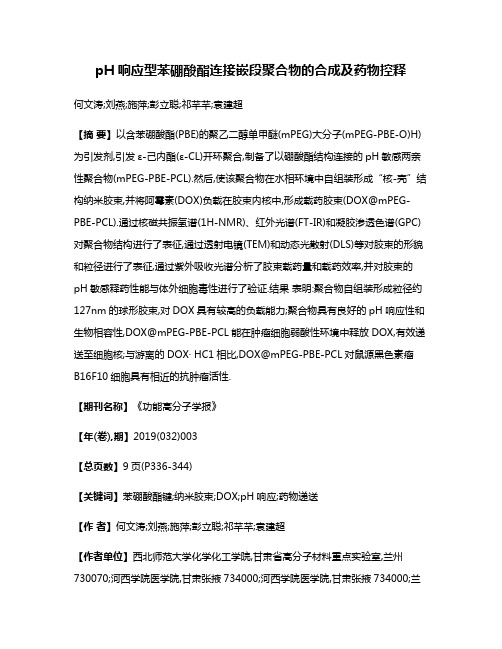
pH响应型苯硼酸酯连接嵌段聚合物的合成及药物控释何文涛;刘燕;施萍;彭立聪;祁芊芊;袁建超【摘要】以含苯硼酸酯(PBE)的聚乙二醇单甲醚(mPEG)大分子(mPEG-PBE-O)H)为引发剂,引发ε-己内酯(ε-CL)开环聚合,制备了以硼酸酯结构连接的pH敏感两亲性聚合物(mPEG-PBE-PCL).然后,使该聚合物在水相环境中自组装形成“核-壳”结构纳米胶束,并将阿霉素(DOX)负载在胶束内核中,形成载药胶束(DOX@mPEG-PBE-PCL).通过核磁共振氢谱(1H-NMR)、红外光谱(FT-IR)和凝胶渗透色谱(GPC)对聚合物结构进行了表征,通过透射电镜(TEM)和动态光散射(DLS)等对胶束的形貌和粒径进行了表征,通过紫外吸收光谱分析了胶束载药量和载药效率,并对胶束的pH敏感释药性能与体外细胞毒性进行了验证.结果表明:聚合物自组装形成粒径约127nm的球形胶束,对DOX具有较高的负载能力;聚合物具有良好的pH响应性和生物相容性,DOX@mPEG-PBE-PCL能在肿瘤细胞弱酸性环境中释放DOX,有效递送至细胞核;与游离的DOX· HC1相比,DOX@mPEG-PBE-PCL对鼠源黑色素瘤B16F10细胞具有相近的抗肿瘤活性.【期刊名称】《功能高分子学报》【年(卷),期】2019(032)003【总页数】9页(P336-344)【关键词】苯硼酸酯键;纳米胶束;DOX;pH响应;药物递送【作者】何文涛;刘燕;施萍;彭立聪;祁芊芊;袁建超【作者单位】西北师范大学化学化工学院,甘肃省高分子材料重点实验室,兰州730070;河西学院医学院,甘肃张掖734000;河西学院医学院,甘肃张掖734000;兰州大学基础医学院病理生理学研究所,兰州730000;西北师范大学化学化工学院,甘肃省高分子材料重点实验室,兰州730070;西北师范大学化学化工学院,甘肃省高分子材料重点实验室,兰州730070;西北师范大学化学化工学院,甘肃省高分子材料重点实验室,兰州730070;西北师范大学化学化工学院,甘肃省高分子材料重点实验室,兰州730070【正文语种】中文【中图分类】O632化疗是癌症最常见的治疗方法之一[1],其中阿霉素(DOX)作为一种最有效的抗肿瘤化疗药物,可以抑制脱氧核糖核酸(DNA)和核糖核酸(RNA)的合成广泛应用于临床[2]。
聚乙二醇硼酸酯的合成和摩擦化学特性
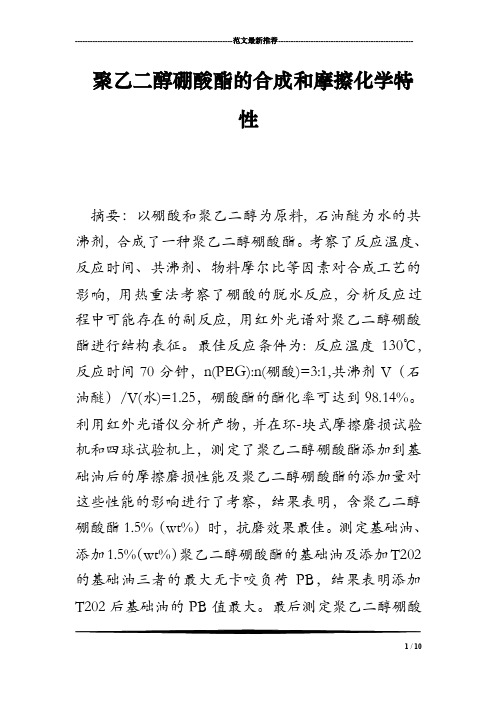
---------------------------------------------------------------范文最新推荐------------------------------------------------------ 聚乙二醇硼酸酯的合成和摩擦化学特性摘要:以硼酸和聚乙二醇为原料, 石油醚为水的共沸剂, 合成了一种聚乙二醇硼酸酯。
考察了反应温度、反应时间、共沸剂、物料摩尔比等因素对合成工艺的影响, 用热重法考察了硼酸的脱水反应, 分析反应过程中可能存在的副反应, 用红外光谱对聚乙二醇硼酸酯进行结构表征。
最佳反应条件为: 反应温度130℃, 反应时间70分钟,n(PEG):n(硼酸)=3:1,共沸剂V(石油醚)/V(水)=1.25,硼酸酯的酯化率可达到98.14%。
利用红外光谱仪分析产物,并在环-块式摩擦磨损试验机和四球试验机上,测定了聚乙二醇硼酸酯添加到基础油后的摩擦磨损性能及聚乙二醇硼酸酯的添加量对这些性能的影响进行了考察,结果表明,含聚乙二醇硼酸酯1.5%(wt%)时,抗磨效果最佳。
测定基础油、添加1.5%(wt%)聚乙二醇硼酸酯的基础油及添加T202的基础油三者的最大无卡咬负荷PB,结果表明添加T202后基础油的PB值最大。
最后测定聚乙二醇硼酸1 / 10酯与T202复配后的摩擦化学性能以及两者的添加量对基础油的摩擦磨损性能的影响,结果表明,当添加1.5%(wt%)聚乙二醇硼酸酯时和添加1%(wt%)T202复配时,润滑油的抗磨效果最佳。
11297关键词:聚乙二醇;硼酸酯;润滑油;摩擦化学特性;T202Abstract: With the boric acid and polyethylene glycol as raw materials, petroleum ether as water entrainer, a polyethylene glycol borate ester synthesis. The effects of reaction temperature, reaction time, azeotropic agent, molar ratio and other factors on the synthesis process, the dehydration reaction of boric acid were investigated by thermogravimetric analysis method, analysis of possible side reactions in the reaction process, the structure was characterized by infrared spectrum of polyethylene glycol borate ester. The optimum reaction conditions were: reaction temperature 130 ℃, reaction time 70 minutes, n (PEG): n (boric acid) =3:1, azeotropic agent V (petroleum ether) /V (water) =1.25, esterification of boric acid ester rate can reach 98.14%. Analysis of the products by using---------------------------------------------------------------范文最新推荐------------------------------------------------------infrared spectroscopy, and in the Block-on-Ring tribometer and four ball testing machine, impact of polyethylene glycol borate is added to the base oil and the friction and wear properties of polyethylene glycol borate ester content on these properties determined were investigated, results showed that, the borate ester containing polyethylene glycol 1.5% (wt%) when the wear. Determination of base oil, adding 1.5% (wt%) maximum base oil polyethylene glycol borate and add T202 of the base oil of the three non-seizure load PB, the results show that the addition of T202 base oil PB maximum. Effects of adding amount of friction, the final determination of chemical properties of polyethylene glycol borate and T202 compound and their friction and wear properties of base oil shows that, when adding 1.5% polyethylene glycol (wt%) borate and adding 1% (wt%) T202 compound, lubricating oil anti-wear effect is best.2.1.1 实验试剂133 / 102.1.2 实验设备132.2 实验仪器介绍132.2.1四球机132.2.2 红外光谱仪142.3 实验方法方框图152.4 实验原理172.5 实验步骤172.5.1聚乙二醇硼酸酯的制备172.5.2 聚乙二醇硼酸酯的红外分析172.5.3 聚乙二醇硼酸酯的摩擦磨损性能及与T202复配后的摩擦磨损18---------------------------------------------------------------范文最新推荐------------------------------------------------------ 3实验结果与讨论193.1硼酸与PEG-200摩尔比对反应的影响193.2共沸剂的比率对反应的影响203.3温度对反应的影响213.4聚乙二醇硼酸酯的红外光谱分析224 聚乙二醇硼酸酯的摩擦磨损性能及与T202复配后的摩擦磨损性能的测定234.1 测试聚乙二醇硼酸酯与T202复配后的摩擦特性234.2磨斑直径与基础油中聚乙二醇硼酸酯的质量百分含量245 / 104.3 各种基础油以及加入1.5%聚乙二醇硼酸酯添加剂后的PB (N)254.4各种载荷下的摩擦系数4.5.4聚乙二醇硼酸酯的制备及T202复配265结论27致谢28参考文献291 绪论1.1 润滑剂的发展近几年来随着人们环保意识的提高,润滑剂发展逐渐向高效、环保发展,水基冲压润滑剂技术正是科学发展的产物。
硼酸酯合成方法
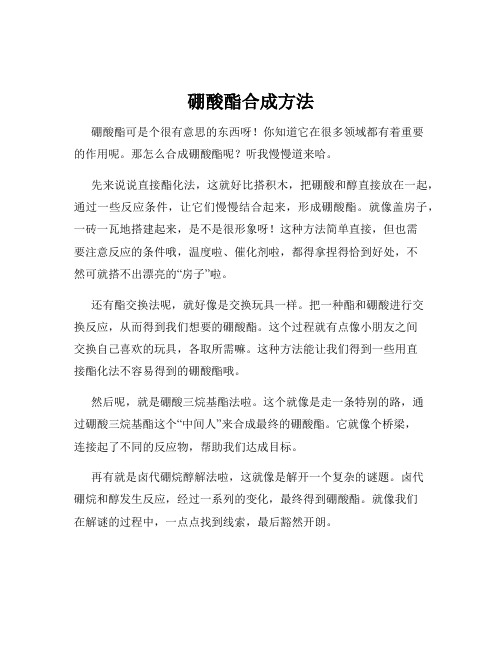
硼酸酯合成方法硼酸酯可是个很有意思的东西呀!你知道它在很多领域都有着重要的作用呢。
那怎么合成硼酸酯呢?听我慢慢道来哈。
先来说说直接酯化法,这就好比搭积木,把硼酸和醇直接放在一起,通过一些反应条件,让它们慢慢结合起来,形成硼酸酯。
就像盖房子,一砖一瓦地搭建起来,是不是很形象呀!这种方法简单直接,但也需要注意反应的条件哦,温度啦、催化剂啦,都得拿捏得恰到好处,不然可就搭不出漂亮的“房子”啦。
还有酯交换法呢,就好像是交换玩具一样。
把一种酯和硼酸进行交换反应,从而得到我们想要的硼酸酯。
这个过程就有点像小朋友之间交换自己喜欢的玩具,各取所需嘛。
这种方法能让我们得到一些用直接酯化法不容易得到的硼酸酯哦。
然后呢,就是硼酸三烷基酯法啦。
这个就像是走一条特别的路,通过硼酸三烷基酯这个“中间人”来合成最终的硼酸酯。
它就像个桥梁,连接起了不同的反应物,帮助我们达成目标。
再有就是卤代硼烷醇解法啦,这就像是解开一个复杂的谜题。
卤代硼烷和醇发生反应,经过一系列的变化,最终得到硼酸酯。
就像我们在解谜的过程中,一点点找到线索,最后豁然开朗。
在合成硼酸酯的过程中,可不是随随便便就能成功的哟!就像做饭一样,调料放多了或者放少了,味道可能就不对啦。
我们得精心地控制各种条件,才能得到我们想要的结果呀。
你想想看,如果反应温度太高了,那不就像火太大把菜烧糊了一样嘛;要是催化剂用得不合适,就好比炒菜忘了放盐,那味道能好吗?所以呀,合成硼酸酯真的是个技术活呢!每种方法都有它的特点和适用情况,我们得根据实际需要来选择合适的方法。
这就好比我们出门穿衣服,得根据天气和场合来选择合适的衣服呀,总不能大冬天穿个短袖就出去了吧!总之呢,合成硼酸酯可不是一件简单的事儿,但只要我们用心去研究,掌握好各种方法和技巧,就一定能合成出高质量的硼酸酯。
这可真是一门有趣又有挑战性的学问呀!大家可得好好琢磨琢磨哦!。
滑石粉在膨胀型透明防火涂料中的协效阻燃和抑烟作用

第51卷第4期2020年4月中南大学学报(自然科学版)Journal of Central South University (Science and Technology)V ol.51No.4Apr.2020滑石粉在膨胀型透明防火涂料中的协效阻燃和抑烟作用徐志胜,谢晓江,颜龙,周寰(中南大学防灾科学与安全技术研究所,湖南长沙,410075)摘要:为了提高透明防火涂料的阻燃和抑烟性能,将滑石粉(talc)与柔性磷酸酯(PPB)反应制备一系列新型磷酸酯接枝滑石粉阻燃剂(TPPBs),再将其与甲醚化三聚氰胺甲醛树脂(MF)复配制备透明防火涂料,并对涂层的防火性能、热稳定性、生烟特性及炭层结构进行表征。
研究结果表明:滑石粉均匀分布在基材树脂中能使涂层保持较高的透明性,并有效增强防火涂料的热稳定性、阻燃和抑烟性能;PPB 与talc 以质量比95׃5复配所制备的涂层表现出最优异的阻燃和抑烟性能,其火焰传播比值和烟密度等级最低,分别为3.1和6.2%;滑石粉的加入能增强磷酸酯的交联反应,形成更多富含磷交联结构和芳香结构以提高涂层的热稳定性和成炭量,并生成更加致密和稳定的膨胀炭层,达到较好的协效阻燃和抑烟效果。
关键词:膨胀型透明防火涂料;滑石粉;阻燃性能;抑烟性能;协效作用中图分类号:X937文献标志码:A开放科学(资源服务)标识码(OSID)文章编号:1672-7207(2020)04-0912-10Synergistic effect of talc on flame retardancy and smoke suppression properties of transparent intumescent fire-retardantcoatingsXU Zhisheng,XIE Xiaojiang,YAN Long,ZHOU Huan(Institute of Disaster Prevention Science and Safety Technology,Central South University,Changsha 410075,China)Abstract:In order to improve the flame retardancy and smoke suppression properties of transparent intumescent fire-retardant coatings,a series of polyphosphate-modified talc(TPPBs)were synthesized by the reaction of flexible polyphosphate flame retardant(PPB)and different contents of talc.Then,the obtained TPPBs were mixed with melamine formaldehyde resin(MF)to prepare transparent intumescent fire-retardant coatings.The flame retardancy,thermal stability,smoke suppression properties and char structures of the coatings were intensively investigated.The results show that the uniform dispersion of talc can achieve a high level of transparency in the coatings,and greatly enhance the thermal stability,flame retardancy and smoke suppression properties of the coatings.When the mass ratio of PPB and talc is 95׃5,the obtained MTPPB3coating exhibits the best flameDOI:10.11817/j.issn.1672-7207.2020.04.006收稿日期:2019−09−26;修回日期:2019−12−14基金项目(Foundation item):国家自然科学基金资助项目(51676210,51906261);湖南省自然科学基金资助项目(2018JJ3668);中南大学研究生自由探索创新项目(506021714)(Projects(51676210,51906261)supported by the National Natural Science Foundation of China;Project(2018JJ3668)supported by the Natural Science Foundation of Hunan Province;Project (506021714)supported by the Graduate Research and Innovation Program of Central South University)通信作者:颜龙,博士,副教授,硕士生导师,从事防火阻燃研究;E-mail :****************第4期徐志胜,等:滑石粉在膨胀型透明防火涂料中的协效阻燃和抑烟作用retardancy and smoke suppression properties among the samples,presenting the lowest flame spread rating of3.1 and smoke density rating of6.2%.The addition of talc can promote to form more phosphorus-rich crosslinking structures and aromatic structures in the condensed phase that produce a more compact and thermally stable char layer against the fire,thus exhibiting excellent synergistic flame-retardant and smoke suppression effects.Key words:transparent intumescent fire-retardant coatings;talc;flame retardancy;smoke suppression;synergistic effect膨胀型透明防火涂料因其具有优异的防火隔热性能以及良好的装饰性能被广泛用于古建筑、现代建筑、文物保护及高档家具等领域的防火保护[1−3]。
硼酸锌的合成研究进展

硼酸锌的合成研究进展张亨【摘要】介绍了硼酸锌的用途、物化性质、生产过程和产品标准.综述了近十年来硼酸锌的合成研究进展情况.【期刊名称】《上海塑料》【年(卷),期】2012(000)004【总页数】4页(P6-9)【关键词】硼酸锌;阻燃剂;性质;工艺;用途;合成【作者】张亨【作者单位】锦西化工研究院,辽宁葫芦岛125000【正文语种】中文【中图分类】TQ128+.540 前言硼酸锌主要用作阻燃剂[1-10],用于聚氯乙烯、聚烯烃、聚酯、卤化聚酯、聚丙烯酸酯、聚醋酸乙烯、ABS树脂、不饱和聚酯等树脂,以及橡胶、涂料、纤维织物等阻燃处理。
它还用作陶瓷釉药、涂料防霉剂、杀菌防霉剂等,也用于医药、防水织物制造等。
1 物化性质[1-3,5-6,8-10]硼酸锌为无规则(或菱形)白色结晶或淡黄色粉末,分子式2ZnO·3B2O3·3.5H2O,相对分子质量434.69,相对密度2.69,熔点980℃。
在冷水中溶解性极低,在热水中缓慢溶解形成质量分数为1%的B2O3的溶液。
硼酸锌易溶于稀酸、氢氧化钠溶液和二甲基亚砜,不溶于乙醇、正丁醇、苯及丙酮等有机溶剂。
在低于260℃硼酸锌仍能保持其结晶水;温度高于300℃时失去结晶水。
硼酸锌热稳定性较好,无毒,既能阻燃,又能消烟,还能熄灭电弧。
硼酸锌有一系列不同组成的化合物。
其中有七水2ZnO·3B2O3·7H2O、五水2ZnO·3B2O3·5H2O、二水ZnO·B2O3·2H2O、无水ZnO·2B2O3和2ZnO·3B2O3等,主要取决于制备方法的差异。
3.5个结晶水的硼酸锌,实际是3.3~3.7个结晶水的。
如无特别说明,阻燃剂硼酸锌一般就是3.5个结晶水的硼酸锌。
2 生产工艺[1-3,7-12]2.1 复分解法复分解法以硼砂和锌盐(硫酸锌、硝酸锌等)为原料,在水溶液中加热进行反应:硼砂和锌盐原料易得,成本较低,在产品粒度控制上有一定的优势。
pd催化硼酸酯制备
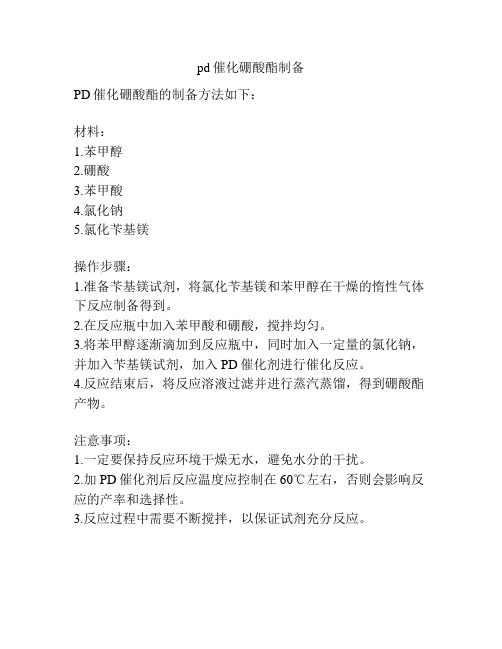
pd催化硼酸酯制备
PD催化硼酸酯的制备方法如下:
材料:
1.苯甲醇
2.硼酸
3.苯甲酸
4.氯化钠
5.氯化苄基镁
操作步骤:
1.准备苄基镁试剂,将氯化苄基镁和苯甲醇在干燥的惰性气体下反应制备得到。
2.在反应瓶中加入苯甲酸和硼酸,搅拌均匀。
3.将苯甲醇逐渐滴加到反应瓶中,同时加入一定量的氯化钠,并加入苄基镁试剂,加入PD催化剂进行催化反应。
4.反应结束后,将反应溶液过滤并进行蒸汽蒸馏,得到硼酸酯产物。
注意事项:
1.一定要保持反应环境干燥无水,避免水分的干扰。
2.加PD催化剂后反应温度应控制在60℃左右,否则会影响反应的产率和选择性。
3.反应过程中需要不断搅拌,以保证试剂充分反应。
硼酸酯的反应类型
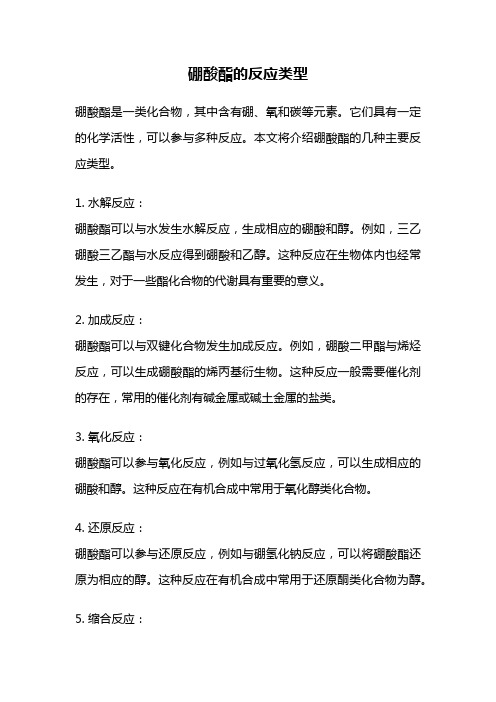
硼酸酯的反应类型硼酸酯是一类化合物,其中含有硼、氧和碳等元素。
它们具有一定的化学活性,可以参与多种反应。
本文将介绍硼酸酯的几种主要反应类型。
1. 水解反应:硼酸酯可以与水发生水解反应,生成相应的硼酸和醇。
例如,三乙硼酸三乙酯与水反应得到硼酸和乙醇。
这种反应在生物体内也经常发生,对于一些酯化合物的代谢具有重要的意义。
2. 加成反应:硼酸酯可以与双键化合物发生加成反应。
例如,硼酸二甲酯与烯烃反应,可以生成硼酸酯的烯丙基衍生物。
这种反应一般需要催化剂的存在,常用的催化剂有碱金属或碱土金属的盐类。
3. 氧化反应:硼酸酯可以参与氧化反应,例如与过氧化氢反应,可以生成相应的硼酸和醇。
这种反应在有机合成中常用于氧化醇类化合物。
4. 还原反应:硼酸酯可以参与还原反应,例如与硼氢化钠反应,可以将硼酸酯还原为相应的醇。
这种反应在有机合成中常用于还原酮类化合物为醇。
5. 缩合反应:硼酸酯可以与醛或酮反应,发生缩合反应生成相应的硼酸酯。
这种反应可以通过酸催化或碱催化来促进。
6. 消除反应:硼酸酯可以参与消除反应,例如与醇酸酐反应,生成相应的醇和酸。
这种反应在有机合成中常用于合成醇类化合物。
7. 脱水反应:硼酸酯可以与醇反应,发生脱水反应生成相应的烯烃。
这种反应在有机合成中常用于合成烯烃类化合物。
8. 烷基化反应:硼酸酯可以与烷基卤化物反应,发生烷基化反应生成相应的酯。
这种反应在有机合成中常用于烷基化反应。
以上是硼酸酯的几种主要反应类型,它们在有机合成中具有重要的应用价值。
通过合理选择反应条件和反应物,可以实现对硼酸酯的有效转化,从而合成出具有特定结构和性质的化合物。
这对于有机化学研究和药物合成具有重要的意义。
一种一乙醇胺硼酸酯的生产工艺[发明专利]
![一种一乙醇胺硼酸酯的生产工艺[发明专利]](https://img.taocdn.com/s3/m/e1eec3f309a1284ac850ad02de80d4d8d15a013c.png)
(19)中华人民共和国国家知识产权局(12)发明专利申请(10)申请公布号 (43)申请公布日 (21)申请号 202011064386.4(22)申请日 2020.09.30(71)申请人 武汉市华中特种油有限公司地址 430000 湖北省武汉市东西湖区走马岭办事处砖厂宿舍159号(13)(72)发明人 晏继源 (74)专利代理机构 深圳市创富知识产权代理有限公司 44367代理人 尹丽华(51)Int.Cl.C07F 5/04(2006.01)(54)发明名称一种一乙醇胺硼酸酯的生产工艺(57)摘要本发明公开了一种一乙醇胺硼酸酯的生产工艺,其通过调整一乙醇胺硼酸酯生产工艺中的各个环节以及收集并监测产物中水的含量,推断一乙醇胺硼酸酯的生产量,使反应产物“一乙醇胺硼酸酯”处于合理的纯度,既可以达到后期运用于金属加工液中的碱储备量,又不至于纯度过高引发反应物结晶而影响后期使用。
权利要求书1页 说明书3页CN 112142768 A 2020.12.29C N 112142768A1.一种一乙醇胺硼酸酯的生产工艺,其特征在于,包括以下步骤:步骤a:按照1:1的质量比依次向反应釜中加入99%的硼酸和99%的一乙醇胺,加热至90℃,并充分搅拌,使硼酸完全溶于一乙醇胺;步骤b:打开反应釜的冷凝回流装置,防止一乙醇胺受热气化逸出;步骤c:继续搅拌,并缓慢升温,至135℃时,调大冷凝回流装置的冷凝功率;步骤d:继续加热,使反应釜内温度保持在135℃以上,同时密切控制加热器的加热功率,保证冷凝回流装置中没有水蒸气逸出;步骤e:使用糖度仪计算冷凝回流的水和一乙醇胺混合液中的含水量,当含水量达到投入的一乙醇胺质量的20%时,即降温停止反应。
2.根据权利要求1所述的一乙醇胺硼酸酯的生产工艺,其特征在于,上述步骤c中,升温速度为3-5℃/min。
3.根据权利要求1所述的一乙醇胺硼酸酯的生产工艺,其特征在于,上述步骤e中,每隔5min对冷凝回流装置中回流的水和一乙醇胺混合液进行一侧抽样检测,当含水量达到投入的一乙醇胺质量的20%时,即降温停止反应。
聚乙二醇硼酸酯的合成
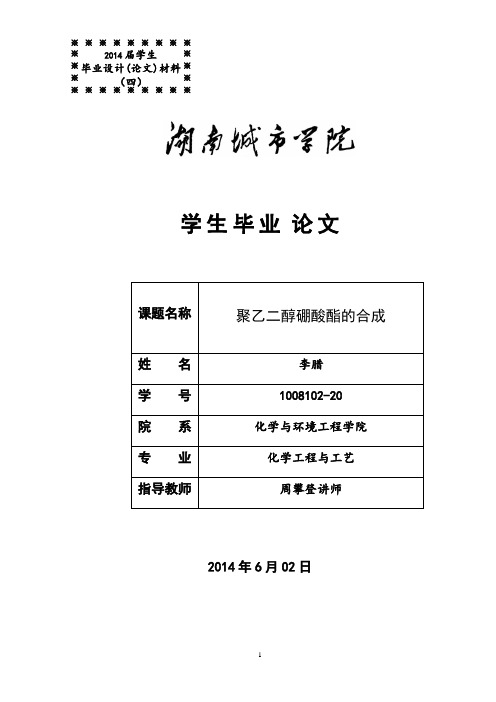
学 生 毕 业 论 文课题名称聚乙二醇硼酸酯的合成姓 名李腊 学 号1008102-20 院 系化学与环境工程学院 专 业化学工程与工艺 指导教师周攀登讲师2014年6月02日※※※※※※※※※※※ ※※※※ ※※※※※※※※※ 2014届学生毕业设计(论文)材料 (四)湖南城市学院本科毕业设计(论文)诚信声明本人郑重声明:所呈交的本科毕业设计(论文),是本人在指导老师的指导下,独立进行研究工作所取得的成果,成果不存在知识产权争议,除文中已经注明引用的内容外,本设计(论文)不含任何其他个人或集体已经发表或撰写过的作品成果。
对本文的研究做出重要贡献的个人和集体均已在文中以明确方式标明。
本人完全意识到本声明的法律结果由本人承担。
本科毕业设计(论文)作者签名:二○一四年六月二日目录1. 绪论 (4)1.1 有机硼酸酯的介绍 (4)1.2 有机硼酸酯的合成方法 (5)1.3铝电解电容器 (6)1.3.1节能灯专用中高压铝电解电容器[4] (6)1.3.2高压铝电解电容器的工作电解液 (7)1.3.3高压铝电解电容器工作电解液的研究进展 (8)1.3.4工作电解液耐高压添加剂的研究进展 (8)1.4有机含硼化合物在导电介质中的应用研究进展 (9)1.5 研究目的、主要工作及意义 (11)1.5.1 研究目的 (11)1.5.2 主要工作 (11)1.5.3 研究意义 (11)2. 聚乙二醇硼酸酯的合成 (13)2.1 引言 (13)2.2 实验部分 (13)2.2.1 实验原料与器材 (13)2.2.2合成原料的选择与合成条件筛选 (14)2.2.3 聚合反应装置 (15)2.2.4 操作方法 (15)3. 结果与讨论 (16)3.1 聚乙二醇硼酸酯的合成工艺 (16)3.1.1 正交实验结果 (16)3.2 产物红外光谱分析 (21)4 结论 (21)参考文献 (21)聚乙二醇硼酸酯的合成李腊(湖南城市学院化学工程与工艺专业2014届学生)摘要:本文采用正交实验和单因素实验方法探讨了硼酸聚酯的最优合成工艺;以最优的工艺条件合成了聚乙二醇硼酸酯。
硼酸酯合成
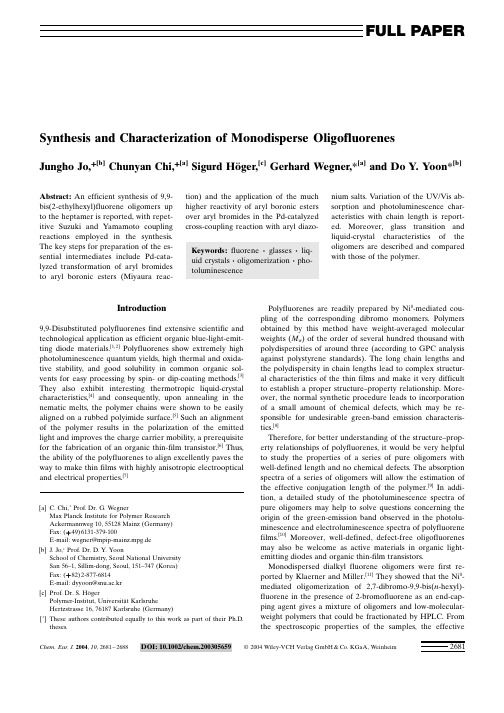
Synthesis and Characterization of Monodisperse OligofluorenesJungho Jo,+[b]Chunyan Chi,+[a]Sigurd Hˆger,[c]Gerhard Wegner,*[a]and Do Y.Yoon*[b]Introduction9,9-Disubstituted polyfluorenes find extensive scientific and technological application as efficient organic blue-light-emit-ting diode materials.[1,2]Polyfluorenes showextremely high photoluminescence quantum yields,high thermal and oxida-tive stability,and good solubility in common organic sol-vents for easy processing by spin-or dip-coating methods.[3]They also exhibit interesting thermotropic liquid-crystal characteristics,[4]and consequently,upon annealing in the nematic melts,the polymer chains were shown to be easily aligned on a rubbed polyimide surface.[5]Such an alignment of the polymer results in the polarization of the emitted light and improves the charge carrier mobility,a prerequisite for the fabrication of an organic thin-film transistor.[6]Thus,the ability of the polyfluorenes to align excellently paves the way to make thin films with highly anisotropic electrooptical and electrical properties.[7]Polyfluorenes are readily prepared by Ni 0-mediated cou-pling of the corresponding dibromo monomers.Polymers obtained by this method have weight-averaged molecular weights (M w )of the order of several hundred thousand with polydispersities of around three (according to GPC analysis against polystyrene standards).The long chain lengths and the polydispersity in chain lengths lead to complex structur-al characteristics of the thin films and make it very difficult to establish a proper structure±property relationship.More-over,the normal synthetic procedure leads to incorporation of a small amount of chemical defects,which may be re-sponsible for undesirable green-band emission characteris-tics.[8]Therefore,for better understanding of the structure±prop-erty relationships of polyfluorenes,it would be very helpful to study the properties of a series of pure oligomers with well-defined length and no chemical defects.The absorption spectra of a series of oligomers will allow the estimation of the effective conjugation length of the polymer.[9]In addi-tion,a detailed study of the photoluminescence spectra of pure oligomers may help to solve questions concerning the origin of the green-emission band observed in the photolu-minescence and electroluminescence spectra of polyfluorene films.[10]Moreover,well-defined,defect-free oligofluorenes may also be welcome as active materials in organic light-emitting diodes and organic thin-film transistors.Monodispersed dialkyl fluorene oligomers were first re-ported by Klaerner and Miller.[11]They showed that the Ni 0-mediated oligomerization of 2,7-dibromo-9,9-bis(n -hexyl)-fluorene in the presence of 2-bromofluorene as an end-cap-ping agent gives a mixture of oligomers and low-molecular-weight polymers that could be fractionated by HPLC.From the spectroscopic properties of the samples,the effective[a]C.Chi,+Prof.Dr.G.WegnerMax Planck Institute for Polymer Research Ackermannweg 10,55128Mainz (Germany)Fax:(+49)6131-379-100E-mail:wegner@mpip-mainz.mpg.de [b]J.Jo,+Prof.Dr.D.Y.YoonSchool of Chemistry,Seoul National University San 56±1,Sillim-dong,Seoul,151±747(Korea)Fax:(+82)2-877-6814E-mail:dyyoon@snu.ac.kr [c]Prof.Dr.S.HˆgerPolymer-Institut,Universit‰t KarlsruheHertzstrasse 16,76187Karlsruhe (Germany)[+]These authors contributed equally to this work as part of their Ph.D.theses.Abstract:An efficient synthesis of 9,9-bis(2-ethylhexyl)fluorene oligomers up to the heptamer is reported,with repet-itive Suzuki and Yamamoto coupling reactions employed in the synthesis.The key steps for preparation of the es-sential intermediates include Pd-cata-lyzed transformation of aryl bromides to aryl boronic esters (Miyaura reac-tion)and the application of the much higher reactivity of aryl boronic esters over aryl bromides in the Pd-catalyzed cross-coupling reaction with aryl diazo-nium salts.Variation of the UV/Vis ab-sorption and photoluminescence char-acteristics with chain length is report-ed.Moreover,glass transition and liquid-crystal characteristics of the oligomers are described and compared with those of the polymer.Keywords:fluorene ¥glasses ¥liq-uid crystals ¥oligomerization ¥pho-toluminescenceFULL PAPERconjugation length was estimated to be approximately 12fluorene units.Lee and Tsutsui prepared a series of oli-gofluorenes up to the tetramer by a repetitive2n divergent approach from2,7-dibromo-9,9-bis(n-hexyl)fluorene,with coupling with bis(n-hexyl)fluorene-2-borate and subsequent bromination of the coupling product.[12]Anemian et al.syn-thesized monodisperse dihexylfluorene oligomers up to the hexamer by a combination of Suzuki and Yamamoto cou-pling reactions.[13]Oligomers with n repeating units contain-ing only one bromine atom at positions2or7on the end fluorenes were prepared by coupling the corresponding monoboronate(nÀ1)with2-bromo-7-iodo-9,9-bis(n-hexyl)-fluorene at the iodo site,which is significantly more reactive than the bromo site.The resulting monobromo oligomers were then coupled by a Yamamoto reaction.Most recently, a detailed description of the synthesis,optical properties, and solid-state properties of defined oligofluorenes,up to the hexadecamer,containing chiral substituents at position9 was presented by Geng et al.[14]Here again,the iodo/bromo selectivity in the Suzuki coupling reaction and the use of tri-methylsilyl groups as dormant iodides were used as key fac-tors in the oligomer synthesis.The enormous success of the Suzuki reaction[15]in the preparation of these oligomers arises from the high yield of the coupling reaction together with the easy availability of the boronic acids and the boronates.[16]They are prepared in good to excellent yields by halogen±metal exchange and subsequent trapping of the aryl lithium compound with trial-kylborates.Recently,the scope of this reaction has been dra-matically expanded by the discovery that aryl boronates are also available directly from the aryl halides by a Pd0-cata-lyzed reaction with the pinacol ester of diboron(the Miyaura reaction).[17]This transformation avoids the use of strongly basic organometallic reagents and thus allows the preparation of a wide variety of functionalized aryl boronic esters.Here,we present the synthesis of oligofluorenes from the dimer up to the heptamer by Suzuki and Yamamoto reac-tions,[18]with the Miyaura reaction employed for the first time for the preparation of the aryl boronates.Also,we have taken advantage of a large difference in the reactivity between aryl diazonium salts and aryl bromides in the Suzuki coupling reaction[19]in the preparation of the key in-termediates.The oligomers have been characterized with re-gards to their optical(absorption and photoluminescence) properties and their phase behavior,including glass transi-tion and liquid-crystal characteristics.Finally,the properties of the oligomers are compared with those of the polymer in order to gain newinsights into the polymer properties.Results and DiscussionSynthesis of oligofluorenes:The synthetic route towards the oligofluorenes is shown in Scheme1.First,2,7-dibromofluor-ene and2-bromofluorene were alkylated with2-ethylhexyl bromide to give the di-and monobromides of fluorene,1 and3,respectively.Both of these compounds,as well as the corresponding boronic acids,have already been reported in the literature.[11±14]However,in our synthesis,we trans-formed the aryl bromides into the corresponding aryl boron-ic esters with the Miyaura reaction.In these reactions the corresponding boronic esters,2and4,are formed in high yields(>90%)and can easily be purified by column pounds4and2were then coupled with3 to give the fluorenyl dimer5and trimer6,respectively. Scheme1.Synthesis of the oligofluorenes:a)2-Ethylhexyl bromide,50% aqueous NaOH/DMSO,room temperature;b)bis(pinacolato)diboron, AcOK/DMF,[Pd(dppf)Cl2],608C;c)[Pd(PPh3)4],toluene/aqueous Na2CO3,reflux;d)BF3¥OEt2,butylnitrite/dichloromethane,À108C;e)Pd(OAc)2/EtOH,reflux;f)Br2,dichloromethane,reflux;g)[Ni(cod)2], COD,Bipy,toluene/DMF,808C.DMSO=dimethylsulfoxide,DMF= N,N-dimethylformamide,dppf=1,1’-bis(diphenylphosphanyl)ferrocene, COD=cycloocta-1,5-diene,Bipy=2,2’-bipyridine.FULL PAPER G.Wegner,D.Y.Yoon et al.To synthesize the longer fluorene oligomers,the unsym-metrical monobrominated intermediates,such as9and11, are essential.However,these intermediates cannot be ob-tained directly by bromination of5or6with bromine,since statistical product mixtures are obtained which are very dif-ficult to separate on a large scale.One possibility to obtain the monobrominated intermediates is to use compounds with one potential reaction site in a protected form(for ex-ample,trimethylsilyl groups instead of bromo or iodo func-tionalities[20])as described by Geng et al.[14]Another way is to use fluorene derivatives with two reaction sites of signifi-cantly different reactivity.In the latter case,the use of bro-moiodofluorene derivatives is quite obvious since the reac-tivity of aryl iodides towards the Suzuki coupling is substan-tially higher than the reactivity of aryl bromides;this con-cept has already been used by Anemian et al.[13]A good alternative approach is to use the large reactivity difference between aryl diazonium salts and aryl bromides in the cross-coupling reaction with aryl boronates.Since the reaction with aryl diazonium salts does not need a base such as Na2CO3,which is essential in the Suzuki coupling reac-tion with aryl bromides,the coupling reaction takes place only at the site of the diazonium salt.Hence,we employed this reaction in our synthetic procedure as follows.2-Amino-7-bromofluorene was alkylated with2-ethylhex-yl bromide to give7in82%yield;7was subsequently trans-formed into the corresponding diazonium salt8(81%). Cross-coupling reaction of4and8with Pd(OAc)2gave9in 70%yield within an hour.This result shows that the reactiv-ity difference between aryl diazonium salts and aryl halides is larger than that between aryl iodides and aryl bromides.9 was transformed into the corresponding boronic ester10in 56%yield with the Miyaura reaction.Subsequently,the cross-coupling reaction of10and8gave11in48%yield. Another method we have used to obtain the monobro-mides is to treat the monoboronate with an excess of the di-bromofluorene.Indeed,the coupling of4with an excess of 1was successfully performed by using only1.5equivalents of1to give the monobrominated dimer9in50%yield(not shown in Scheme1).Similarly,the monobrominated trimer 11was obtained in45%yield by the reaction of4with1.5-fold excess of the dibrominated product12,which was pre-pared from5in90%yield.[21]Both methods led to identical compounds,thereby demonstrating the validity of our syn-thetic methodology.Yamamoto homocoupling re-actions of9and11gave the flu-orenyl tetramer13and hexam-er15,respectively,both in%50%yield.The fluorenylpentamer14was obtained witha cross-coupling reaction of9and2in47%yield.The highreactivity of the diazonium saltswas also used to prepare the di-bromofluorenyl trimer16,which was obtained in54%yield by coupling of2and8.Although16can,in principle,also be prepared by the bromination of6,a detailed mass spectral analysis of the crude reaction products showed that varying amounts of tribromide contaminate the dibromide. Since even small amounts of an impurity affect the liquid-crystalline behavior of the oligomers,we avoided the bromi-nation of the fluorenyl trimer and higher oligomers in our oligomer synthesis.The fluorenyl heptamer17was obtained in38%yield by cross-coupling reaction of10and16. Optical properties of oligofluorenes:Electronic absorption spectra of monodisperse oligo(9,9-bis(2-ethylhexyl)fluorene-2,7-diyl)compounds5,6,13,14,15,and17in diluted chloroform solution with the same fluorene unit concentra-tion(1.0î10À5m)are shown in Figure1and the data are col-lected in Table1.The oligofluorenes exhibit unstructured absorption bands, as is also seen for polyfluorenes.[3]The absorption maximum is red-shifted with increasing number(n)of fluorene units. The molar extinction coefficients(e)of the oligofluorenes showa good approximation of a linear increase w ith n from dimer to heptamer,as seen in Table1.The increment is 30.3î103L molÀ1cmÀ1for each repeat unit.The plot of the wave number of the maximum absorption versus1/nfollows Figure1.UV/Vis absorption of oligofluorenes(dimer to heptamer)in chloroform solution at room temperature at a fixed concentration of flu-orene repeat units of1.0î10À5mole LÀ1.Table1.Summary of UV/Vis absorption(n max(abs))and photoluminescence(n max(PL))spectra for the fluoreneoligomers and polymer,from chloroform solutions and solid films.[a]Sample Solution Filmn max(abs)e max n max(PL)n max(abs)n max(PL)[cmÀ1][L molÀ1cmÀ1][cmÀ1][cmÀ1][cmÀ1]dimer530580491702740025970304002710025770trimer628740813302538024100286502513023870tetramer13279301115002475023470275502439023200pentamer14274001417002445023150270302398022940hexamer15271701730002433023040268802381022780heptamer17268802003002427023040268102370022730polymer26110±2410022940259102359022570[a]Since the resolution of the low-energy peak was too low at the temperature at which the data were record-ed,only the n max values of the two high-energy components are given.Synthesis and Characterization of Monodisperse Oligofluorenes2681±2688a linear fit,as shown in Figure 2.The polymer has a maxi-mum absorption at 26110cm À1(383nm);[3]hence,we can estimate an effective conjugation length of 14repeat unitsfrom the plot in Figure 2,a figure that can be compared with the reported value of 12for poly(9,9-bis(n -hexyl)fluor-ene-2,7-diyl).[11]The UV/Vis absorption spectra of thin films of the oligofluorenes on quartz substrates are practically identical to the solution data except for slight red-shifts in the absorption maxima,as listed in Table 1.Figure 3a shows the photoluminescence (PL)spectra of the oligomers from dimer 5to heptamer 17in chloroform with the same concentration of fluorene units (1.0î10À6m ),excited at the corresponding energy of maximum absorp-tion.Similar to polyfluorenes,three well-resolved fluores-cence bands are observed.They may be assigned to the 0±0,0±1,and 0±2intrachain singlet transitions.[22]The spectral position and the intensity of the PL maximum changes with the number of fluorene units,n .This is explained by the in-crease of effective conjugation from dimer 5up to heptamer 17.Notably,the relative intensity of the three emission bands also changes with n .The relative intensity of the 0±0transition increases with n ,while that of the 0±2transition decreases.This may be related to an increase of the intra-chain coupling interaction with the molecule×s length.Normalized solid-state PL spectra of oligofluorenes 5,6,13,14,15,and 17from thin films on a quartz plate excited at the absorption maxima are shown in Figure 3b and the key data are listed in Table 1.Relative to the PL spectra measured in solution,red shifts in the emission maxima are observed and the relative intensities of the 0±2intrachain singlet transition increase in all cases.Most importantly,the green-band emission usually seen for the polymer [3]is absent for all of the oligomers (Figure 3b).Even upon high-temperature annealing (1808C)in air,this green emission is still negligible for the oligomers.This result casts doubt on the widely discussed hypothesis that the green emission seen with varable intensity in polymer samples (Figure 3b)origi-nates from excimer formation by interchain interaction.It is difficult to see why such interchain interactions should be suppressed in the case of oligomers if this explanation was true.Phase transition characteristics of oligofluorenes :The DSC traces shown in Figure 4clearly exhibit the glass transition temperatures for all of the oligomers in the low-temperature range,followed by an endothermic transition for the tetram-er 13,pentamer 14,hexamer 15,and heptamer 17as the temperature is increased.The latter transition is identified as the liquid-crystalline to isotropic transition from the po-larized optical microscopy study.The Schlieren texture and the very small enthalpy value of the transition,as shown in Table 2,indicate that the liquid-crystal structure is probably of nematic character,but a further study on this topic is in progress.The isotropization temperature T iso of this liquid-crystal-line to isotropic transition extrapolates to a hypothetical T iso (Polymer)for n !¥of 4758C if plotted in the coordi-nates T iso =T iso (n !¥)(1ÀKX E )where X E is the molefrac-Figure 2.Plot of n ˜max versus reciprocal degree of polymerization n.Figure 3.a)Fluorescence spectra of oligofluorenes (dimer to heptamer)in chloroform solution at room temperature at a fixed concentration of fluorene repeat units of 1î10À6mole L À1.b)Photoluminescence spectra of thin films of the oligofluorenes (dimer to heptamer).The spectrum for the polymer,also shown in this figure,was obtained for a sample an-nealed at 1808C for 1h in air.FULL PAPERG.Wegner,D.Y.Yoon et al.tion of end groups and K is an empirical constant.This tem-perature is well above the decomposition range of the high polymer.In this regard,it is important to note that the poly-mer exhibits a well-known ™melting∫transition around 1608C.Above 1608C the polymer exists in a nematic liquid-crystal phase;belowthat temperature another solid phase is formed,the true nature of which is not yet understood.It may be of higher order smectic type but of such a rigidity of the packing that a transition to a glassy state is suppressed.Whether this substantial difference in the phase structure and nature of transitions has consequences for the electro-optical properties of these materials needs to be studied fur-ther.The glass transition temperatures,listed in Table 2,tend to level off as the chain length increases and exhibit n À1de-pendence of the type:T g =64.0À174.7n À1.Therefore,the extrapolated T g for the polymer is estimat-ed to be approximately 648C.The occurrence of this glass transition is difficult,if not impossible,to see in the DSC thermogram for the polymer (see Figure 4).This may be due to the above-mentioned differences of the liquid-crystal phases in the polymer and in the oligomers.ConclusionOligofluorenes up to the heptamer can be synthesized on the hundred-milligram scale by a stepwise route involving Suzuki and Yamamoto coupling reactions.The synthesis of the boronates for the Suzuki coupling is based on the Pd-catalyzed transformation of aryl bromides into boronates,a process that avoids strongly basic aryl lithium intermediates.Therefore,this methodology has potential for the synthesis of oligofluorenes containing a variety of functional groups.The synthesis of mono-or dibrominated fluorenyl oligomers,which are essential for expanding of the chain length,is based on the much higher reactivity of aryl boronates over aryl bromides in the Pd-catalyzed cross-coupling reaction with aryl diazonium salts.The pure oligomers as solid films do not showthe unde-sired green-band emission characteristics of the polymer.Moreover,they are found to align more readily to form monodomains on various surfaces,as will be published else-where.The oligomers from tetramer to heptamer show a liquid-crystal phase with clearly defined isotropization tem-peratures;this allows extrapolation to the expected isotropi-zation temperature of the polymer at around 4758C,well above the thermal decomposition temperature.Most impor-tantly,the oligofluorenes do not showthe same high-order phase that the polymer exhibits belowthe melting tempera-ture of approximately 1608C.However,unlike the polymer,the oligomers do showa glass transition temperature w hichexhibits n À1dependence and allows extrapolation to a hypo-thetical glass transition of the polymer at around 648C.As this glass transition refers to a freezing of a liquid-crystal phase not seen for the polymer,it is not too surprising that this phenomenon cannot be detected for the polymer.Experimental SectionGeneral remarks :Reactions requiring an inert gas atmosphere were con-ducted under argon and the glassware was oven-dried (1408C).Tetrahy-drofuran (THF)was distilled from potassium prior to mercially available chemicals were used as received.1H NMR and 13C NMR spec-tra were recorded on Bruker DPX 250or AC 300spectrometers (250and 300MHz for 1H,62.5and 75.48MHz for 13C).Chemical shifts are given in ppm,referenced to residual proton resonances of the solvents.Thin-layer chromatography was performed on aluminium plates precoated with Merck 5735silica gel 60F 254.Column chromatography was per-formed with Merck silica gel 60(230Æ400mesh).Field desorption spec-tra were recorded on a VG ZAB 2-SE FPD machine.Differential scan-ning calorimetry was measured on a Mettler DSC 30with a heating or cooling rate of 10K min À1.Polarization microscopy was performed on a Zeiss Axiophot apparatus with a nitrogen-flushed Linkam THM 600hot stage.UV/Vis spectra were recorded at room temperature with a Perkin±Elmer Lambda 9UV/Vis/NIR spectrophotometer.Photoluminescence spectra were obtained on a Spex Fluorolog II (212)apparatus.Optical properties of solid thin films were normally obtained for samples spin-coated on a quartz substrate from dilute chloroform solutions and dried under vacuum.Elemental analysis were performed by the University of Mainz.Melting points were measured with a Reichert hot-stage appara-tus and are uncorrected.2,7-Dibromo-9,9-bis(2-ethylhexyl)fluorene (1):2-Ethylhexylbromide (38.73g,185.18mmol,35.74mL)was added to a mixture of 2,7-dibromo-fluorene (25.0g,77.16mmol)and triethylbenzylammonium chloride (0.878g, 3.86mmol,5mol %)in DMSO (125mL)and 50%aqueousFigure 4.DSC traces for the oligofluorenes (dimer to heptamer;second heating at 108C min À1).The DSC trace for the polymer is also shown for comparison.Table 2.Summary of glass transition temperature (T g ),isotropization temperature (T iso ),and the enthalpy of isoptropization value (D H iso )for the oligofluorenes.Sample T g [K]T iso [K]D H iso [J g À1]dimer 5252±±trimer 6274±±tetramer 132953370.50pentamer 143013990.47hexamer 153074630.71heptamer 173155190.74Synthesis and Characterization of Monodisperse Oligofluorenes 2681±2688NaOH(31mL).The reaction mixture was stirred at room temperature for5h.An excess of diethyl ether was added,the organic layer was washed with water,diluted HCl,and brine,then dried over MgSO4.The solvent was removed under vacuum and the residue was purified by column chromatography over silica gel with n-hexane as the eluent(R f= 0.78)and solidified from EtOH atÀ308C to give1as a white solid (36.21g,85.6%):M.p.45±548C;1H NMR(250MHz,CD2Cl2):d=7.57±7.43(m,6H),1.94(d,J=5.35Hz,4H),0.89±0.68(m,22H),0.55±0.41(m, 8H)ppm;13C NMR(62.5MHz,CDCl3):d=152.3,139.1,130.1,127.4, 121.0,55.3,44.3,34.6,33.6,28.0,27.1,22.7,14.0,10.3ppm;MS(FD): m/z:548.2[M+].2-Bromo-9,9-bis(2-ethylhexyl)fluorene(3):Compound3was prepared ac-cording to the method used for1by using2-ethylhexylbromide(43.3g, 224.5mmol,39.9mL),2-bromofluorene(25.0g,102.0mmol),triethylben-zylammonium chloride(1.16g,5.10mmol,5mol%),DMSO(165mL), and50%aqueous NaOH(41mL).Purification by column chromatogra-phy over silica gel with n-hexane as the eluent(R f=0.72)gave3as a col-orless liquid(43.14g,90.1%):1H NMR(250MHz,CD2Cl2):d=7.70±7.26 (m,7H),1.97(m,4H),0.90±0.43(m,30H)ppm;13C NMR(62.5MHz, CDCl3):d=152.8,150.0,140.3,129.8,127.3,126.9,124.0,120.9,120.4, 119.6,55.1,44.4,34.6,33.6,28.0,27.0,22.7,14.0,10.4ppm;MS(FD): m/z:470.2[M+].2,7-Bis(4,4,5,5-tetramethyl[1.3.2]dioxaborolan-2-yl)-9,9-bis(2-ethylhexyl)-fluorene(2):Under an argon atmosphere,1(2.43g,4.43mmol),bis(pina-colato)diboron(4.05g,15.94mmol),KOAc(2.60g,26.57mmol),and Pd(dppf)Cl2(0.226g,0.266mmol)were dissolved in DMF(40mL)and heated to608C overnight.After the reaction mixture was cooled to room temperature,water and diethyl ether were added.The aqueous phase was extracted with diethyl ether and the combined organic layers were dried over MgSO4.The solvent was removed under vacuum and the resi-due was purified by column chromatography over silica gel with petrole-um ether/dichloromethane(3:1)as the eluent(R f=0.34)and solidified from EtOH atÀ308C to give2as a white solid(2.60g,91.5%):M.p.85.5±87.68C;1H NMR(250MHz,CD2Cl2):d=7.84±7.69(m,6H),2.00 (d,J=5.3Hz,4H), 1.36(s,24H),0.86±0.50(m,22H),0.48±0.45(m, 8H)ppm;13C NMR(62.5MHz,CDCl3):d=150.1,143.9,133.5,130.4, 119.2,83.5,54.7,44.0,34.6,33.5,27.8,27.2,24.8,22.7,14.1,10.3ppm;MS (FD):m/z:643.0[M+].2-(4,4,5,5-Tetramethyl[1.3.2]dioxaborolan-2-yl)-9,9-bis(2-ethylhexyl)fluor-ene(4):Compound4was prepared according to the method used for2 by using3(14.07g,30.0mmol),bis(pinacolato)diboron(12.19g, 48.0mmol),KOAc(8.82g,90.0mmol),and[Pd(dppf)Cl2](1.23g, 1.5mmol)in DMF(300mL).Column chromatography over silica gel with petroleum ether/dichloromethane(4:1)as the eluent(R f=0.59)af-forded4as an oily product(14.78g,95.5%):1H NMR(250MHz, CD2Cl2):d=7.82±7.64(m,4H),7.36±7.21(m,3H),2.0±1.86(m,4H), 1.34(s,24H),0.86±0.65(m,22H),0.50±0.43(m,8H)ppm;13C NMR (62.5MHz,CDCl3):d=151.0,149.5,144.2,141.1,133.6,130.3,126.6, 124.1,120.0,118.8,83.5,54.8,44.5,44.1,34.6,33.5,28.2,27.8,27.3,26.8, 24.8,22.7,14.1,10.5,10.1ppm;MS(FD):m/z:516.7[M+].9,9,9’,9’-Tetrakis(2-ethylhexyl)-2,2’-bifluorene(5):A mixture of4(5.17g, 10.0mmol)and3(4.69g,10.0mmol)in toluene(50mL)and2m aqueous Na2CO3solution(25mL,50mmol)was degassed by pump and freeze cycles(3î)and[Pd(PPh3)4](0.577g,0.5mmol)was added under argon. The solution was heated to reflux with vigorous stirring for20h.After the reaction mixture was cooled to room temperature,diethyl ether and water were added.The organic layer was separated and washed with di-luted HCl and brine,then dried over MgSO4.The solvent was removed under vacuum and the residue was purified by column chromatograpy over silica gel with petroleum ether as the eluent(R f=0.47)to give5 (7.08g,90.8%):1H NMR(250MHz,CD2Cl2):d=7.73±7.80(m,4H), 7.57±7.64(m,4H),7.25±7.44(m,6H),2.04±2.14(m,8H),0.49±0.88(m, 60H)ppm;13C NMR(62.5MHz,CDCl3):d=150.9,150.6,141.1,140.4, 126.8,126.3,126.0,124.1,122.9,119.6,54.9,44.5,34.6,33.8,28.2,26.9, 22.7,14.0,10.3ppm;MS(FD):m/z:779.4[M+];elemental analysis: calcd for C58H82(779.2):C89.39,H10.61;found:C89.29,H10.79.9,9,9’,9’,9’’,9’’-Hexakis(2-ethylhexyl)-2,2’-7’,2’’-terfluorene(6):Compound 6was prepared according to the method used for5by using2(2.0g, 3.12mmol),3(4.40g,9.36mmol),and[Pd(PPh3)4](0.36g,0.31mmol)in toluene(30mL)and2m Na2CO3aqueous solution(15.6mL,31.2mmol)for27h.After cooling to room temperature,the mixture was diluted with ethyl acetate and the organic layer was washed with diluted HCl and brine,then dried over MgSO4.The solvent was removed under vacuum and the residue was purified by column chromatography over silica gel with petroleum ether as the eluent(R f=0.22)to give6as a col-orless viscous gum(2.32g,63.8%):1H NMR(250MHz,CD2Cl2):d= 7.83±7.73(m,6H),7.61±7.66(m,8H),7.44±7.25(m,6H),2.13±2.05(m, 12H),0.90±0.49(m,90H)ppm;13C NMR(62.5MHz,CDCl3):d=151.2, 150.9,150.6,141.1,140.4,140.1,126.8,126.3,126.0,124.1,122.9,119.7, 119.6,54.9,44.6,34.6,33.8,28.2,27.1,22.8,14.0,10.3ppm;MS(FD):m/ z:1168.2[M+];elemental analysis:calcd for C87H122(1167.9):C89.47,H 10.53;found:C89.26,H10.42.2-Amino-7-bromo-9,9-bis(2-ethylhexyl)fluorene(7):Compound7was prepared according to the method used for1by using2-ethylhexylbro-mide(7.78g,40.3mmol,7.2mL),2-amino-7-bromofluorene(5.0g, 19.2mmol),triethylbenzylammonium chloride(220mg,1mmol,5 mol%),DMSO(50mL),and50%aqueous NaOH(3.8mL).The reac-tion mixture was stirred for2h.Purification by column chromatography over silica gel with n-hexane/dichloromethane(6.5:3.5)as the eluent (R f=0.47,0.44,and0.38;the title product separated into three spots,due to the diaseteroisomers)gave7as a slightly yellowoily product(7.65g, 82%):1H NMR(300MHz,CD2Cl2):d=7.46±7.37(m,4H),6.70±6.63(m, 2H),3.81(br s,2H),1.84±1.90(m,4H),0.92±0.73(m,22H),0.57±0.52 (m,8H)ppm;13C NMR(75MHz,CDCl3):d=152.5±152.4(three peaks, 2îC),146.9±146.8(three peaks),141.4,131.5±131.4(three peaks),129.8, 127.4±127.3(three peaks),120.9,119.9,118.7±118.5(three peaks),114.2, 110.9±110.8(three peaks),55.2,44.9±44.8(four peaks),35.0,33.9±33.7 (four peaks),28.5±28.3(four peaks),23.2,14.3,10.6±10.4(four peaks)ppm;MS(FD):m/z:484.0[M+].2-Bromo-9,9-bis(2-ethylhexyl)fluorenyl-7-diazonium tetrafluoroborate (8):A solution of7(3.48g,7.18mmol)in CH2Cl2(10mL)was slowly added to BF3¥OEt2(11.46mmol,1.42mL)with stirring under an argon athmosphere atÀ108C.After10min,a solution of butyl nitrite(1.18mL, 10.01mmol)in CH2Cl2(4mL)was slowly added and the mixture stirred for additional30min at08C.n-Pentane(200mL)was added and the mix-ture was stored atÀ208C overnight.The precipitate was filtered off, washed with cold diethyl ether and dried in air to give8as a pale yellow solid(3.39g,81%):1H NMR(300MHz,[D6]acetone):d=9.08(m,1H), 8.87(m,1H),8.53(m,1H),8.16(m,1H),8.06(s,1H),7.77(m,1H), 2.30±2.20(m,4H),0.88±0.45(m,1H)ppm;13C NMR(75MHz,acetone-d6):d=156.6,154.2±153.9(three peaks),153.8,137.9±137.8(three peaks), 134.6,132.6±132.5(three peaks),129.5±129.4(three peaks),129.0±128.8 (three peaks),126.7,125.8,123.7±123.6(three peaks),111.9±111.6(three peaks),57.6±57.5(three peaks),44.5±44.3(four peaks),35.9±35.8(two peaks),34.7±33.9(three peaks),28.9±28.5(three peaks),28.0,23.4±23.3 (two peaks),14.3±14.2(two peaks),10.7±10.3(three peaks)ppm;decom-position temperature:988C.7-Bromo-9,9,9’,9’-tetrakis(2-ethylhexyl)-2,2’-bifluorene(9):A mixture of 4(0.90g, 1.74mmol),8(1.12g, 1.92mmol),and Pd(OAc)2(40mg, 0.178mmol)in ethanol(30mL)was heated to608C for1h(no addition-al base was added).After cooling to room temperature,the mixture was diluted with diethyl ether and the organic layer was washed with brine and dried over MgSO4.The solvent was removed under vacuum and the residue was purified by column chromatography over silica gel with pe-troleum ether as the eluent(R f=0.49)to give9as an oily product(1.04g,70%):1H NMR(250MHz,CD2Cl2):d=7.80±7.26(m,13H),2.14±2.04(m,8H),0.88±0.52(m,60H)ppm;13C NMR(62.5MHz, CDCl3):d=153.0,151.0,150.6,141.0,140.5,140.1,139.2,129.9,127.4, 126.8,126.4,126.0,124.1,122.9,120.9,120.3,119.6,54.9,44.5,34.6,33.8, 28.2,27.1,22.7,14.0,10.3ppm;MS(FD):m/z:857.6[M+].2-[9,9,9’,9’-Tetrakis(2-ethylhexyl)-7,2’-bifluoren-2-yl]-4,4,5,5-tetrame-thyl[1.3.2]dioxaborolan(10):Compound10was prepared according to the method used for2by using9(970mg,1.1mmol),bis(pinacolato)di-boron(450mg,1.8mmol),KOAc(326mg,3.3mmol),and[Pd(dppf)Cl2] (45mg,0.055mmol)in DMF(10mL).Column chromatography over silica gel with n-hexane/CH2Cl2(9:1)as the eluent(R f=0.12)gave10as an oily product(570mg,55.7%):1H NMR(300MHz,CD2Cl2):d=7.86±7.73(m,6H),7.65±7.60(m,4H),7.41(m,1H),7.36±7.27(m,2H),2.09±2.04(m,8H),1.35(s,12H),0.88±0.49(m,90H)ppm;13C NMR(75MHz, CD2Cl2):d=152.8,151.6,151.3,150.5±150.3,144.6,141.7,141.1±140.6, 134.1,131.1±130.9,127.4,127.0,126.6±126.5,124.8,123.6±123.4,120.8,FULL PAPER G.Wegner,D.Y.Yoon et al.。
硼酸酯的合成及水解稳定性
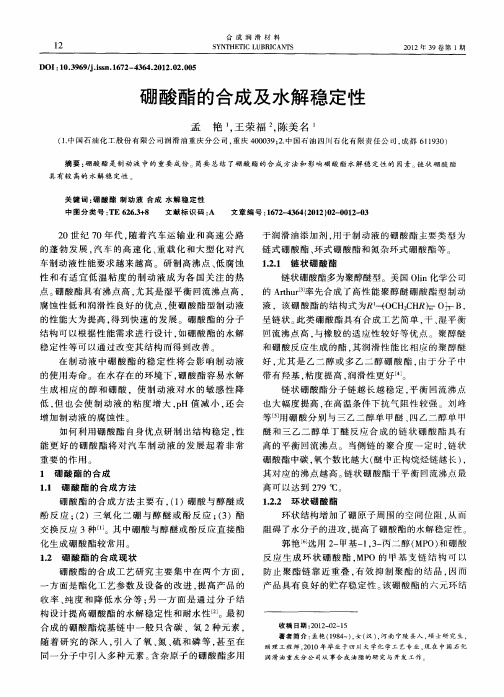
降 低 ;而 在 大 环状 结 构 硼 酸 酯 中 ,干沸 点则 随着 侧
链 中碳 氧个 数 比的增 加 而升高 。
1.2.3 氮杂 环硼 酸酯
氮杂环 硼酸 酯具 有 较高 的沸点 ,适 宜 的运 动粘
度 ,良好 的润滑 性 和极佳 的抗 腐 蚀性 。氮杂 环 硼酸
酯 的结 构可 表示 为 l8]:
12
ቤተ መጻሕፍቲ ባይዱ
合 成 润 滑 材 料 SYNTHETIC LUBRICANTS
DOI:10.3969/j.issn.1672-4364.2012.02.005
2012年 39卷第 1期
硼 酸 酯 的合成 及 水 解 稳定 性
孟 艳 ,王荣 福 ,陈美 名
(1.中国 石 油 化 工股 份有 限公 司润 滑 油 重 庆 分公 司 ,重 庆 400039;2.中 国石 油 四川 石 化 有 限 责任 公 司 ,成 都 611930)
20世 纪 70年代 ,随着 汽 车运 输业 和 高 速公 路 的蓬 勃 发展 ,汽 车 的高 速 化 、重 载 化 和大 型 化对 汽 车制 动 液性 能要 求越来 越 高 。研 制高 沸点 、低 腐蚀 性 和 有 适 宜低 温 粘 度 的制 动 液 成 为各 国关 注 的热 点 。硼 酸酯具 有 沸点 高 ,尤 其是 湿平 衡 回流沸 点高 , 腐 蚀性 低 和润 滑性 良好 的优 点 .使 硼 酸酯 型制 动 液 的性能 大 为提 高 ,得 到快 速 的发展 。硼酸 酯 的分 子 结 构可 以根 据性 能需 求进 行设 计 ,如 硼酸 酯 的水解 稳 定性 等可 以通过改 变其 结构 而得 到改 善 。
链 状 硼酸酯 分子 链越 长 越稳 定 ,平 衡 回流沸点 也大 幅度 提高 ,在 高温条 件下 抗气 阻 性较 强 。刘 峰 等 l5 用 硼 酸分 别 与三 乙二 醇 单 甲醚 、四乙二 醇 单 甲 醚 和 三 乙二 醇单 丁 醚 反应 合 成 的链 状 硼 酸 酯 具有 高 的平衡 回流 沸点 。 当侧链 的 聚合度 一定 时 ,链状 硼酸 酯 中碳 ,氧个 数 比越 大 (醚 中正构烷烃链 越长 ), 其对 应 的沸点 越高 。链状 硼 酸酯干 平衡 回流 沸点 最 高可 以达 到 279 cc。 1.2.2 环 状 硼 酸 酯
聚乙二醇硬脂酸酯的合成与应用

聚乙二醇硬脂酸酯的合成与应用作者:宋伟来源:《中国石油和化工标准与质量》2013年第10期【摘要】聚乙二醇硬脂酸酯是一种非离子型表面活性剂,是日常工业生产不可或缺的原材料。
主要是因为聚乙二醇硬脂酸酯具有很大的高乳化能力、低泡沫力和具有良好润湿性能等优势,被广泛的应用到印花乳剂、化妆品乳剂等,甚至还涉及到诸多的日用化工、食品、纺织、农药以及金属加工等领域。
本文首先详细诠释聚乙二醇硬脂酸酯的定义,总结出聚乙二醇硬脂酸酯的市场应用及需求,最后通过实验的方法详细分析出聚乙二醇单硬脂酸酯合成方法。
【关键词】聚乙二醇硬脂酸酯合成应用聚乙二醇硬脂酸酯是重要的供应原料,被广泛的应用到日常生产活动中。
为此,聚乙二醇硬脂酸酯合成条件的优化显得尤为重要,目前聚乙二醇脂肪酸酯的合成主要有三个途径:乙氧基化法、直接酯化法和酰氯醇解法。
在合成反应中要想达到其最佳条件,就要在物料配比、反应时间和温度上进行合理的把控,这样才能使聚乙二醇硬脂酸酯合成反应达到最佳条件。
1 聚乙二醇硬脂酸酯的定义所谓的聚乙二醇双硬脂酸酯(DS6000)是工业生产活动中重要的原材料之一,由于其具有较高的高乳化能力、低泡沫力和良好润湿性能,使得这种非离子表面活性剂可以替代脂肪醇聚氧乙烯,在日用化学、食品、农药、纺织、金属加工等领域具有极大的利用率,并有逐年增多的迹象,特别是在“十五”期间,聚乙二醇双硬脂酸酯是精细化工产品中重点的研究对象。
目前,研究聚乙二醇硬脂酸酯合成主要有乙氧基化法、直接酯化法和酰氯醇解法三种方法。
其中乙氧基化法主要利用的是环氧乙烷和脂肪酸药品,使得在碱性条件下进行反应,虽然这类产品的纯度较高,但是采用乙氧基化法中使用的环氧乙烷具有较高的反应活性,对实验研究的控制力度较弱,同时环氧乙烷在实验过程中要求的工艺条件也非常严格,必须在氮气保护和高压釜内进行。
采用直接酯化法合成聚乙二醇硬脂酸酯也有很多的缺点弊端,主要是在实验过程中其反应时间长,操作条件严格,反应温度高,很容易腐蚀设备,其增稠性不十分理想。
硼酸酯迭代:二乙醇胺(DEA)硼酸酯
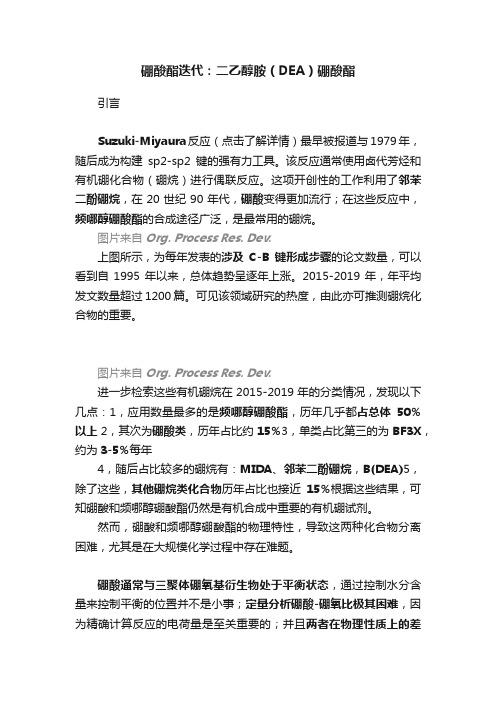
硼酸酯迭代:二乙醇胺(DEA)硼酸酯引言Suzuki-Miyaura反应(点击了解详情)最早被报道与1979年,随后成为构建sp2-sp2键的强有力工具。
该反应通常使用卤代芳烃和有机硼化合物(硼烷)进行偶联反应。
这项开创性的工作利用了邻苯二酚硼烷,在20世纪90年代,硼酸变得更加流行;在这些反应中,频哪醇硼酸酯的合成途径广泛,是最常用的硼烷。
图片来自Org. Process Res. Dev.上图所示,为每年发表的涉及C-B键形成步骤的论文数量,可以看到自1995年以来,总体趋势呈逐年上涨。
2015-2019年,年平均发文数量超过1200篇。
可见该领域研究的热度,由此亦可推测硼烷化合物的重要。
图片来自Org. Process Res. Dev.进一步检索这些有机硼烷在2015-2019年的分类情况,发现以下几点:1,应用数量最多的是频哪醇硼酸酯,历年几乎都占总体50%以上2,其次为硼酸类,历年占比约15%3,单类占比第三的为BF3X,约为3-5%每年4,随后占比较多的硼烷有:MIDA、邻苯二酚硼烷,B(DEA)5,除了这些,其他硼烷类化合物历年占比也接近15%根据这些结果,可知硼酸和频哪醇硼酸酯仍然是有机合成中重要的有机硼试剂。
然而,硼酸和频哪醇硼酸酯的物理特性,导致这两种化合物分离困难,尤其是在大规模化学过程中存在难题。
硼酸通常与三聚体硼氧基衍生物处于平衡状态,通过控制水分含量来控制平衡的位置并不是小事;定量分析硼酸-硼氧比极其困难,因为精确计算反应的电荷量是至关重要的;并且两者在物理性质上的差异(反应性、稳定性和溶解性)可能会对原料药控制策略产生负面影响。
此外,频哪醇硼酸酯经常用于克服上述挑战,但它们本身很难制备,特别是大规模制备时,而且在Suzuki-Miyaura反应中表现出较低的反应活性。
至关重要的是,硼酸或频哪醇硼酸酯需要通过结晶固体中间体进行的大规模隔离或降水过程,而不是使用典型的实验室方法(比如旋转蒸发干燥或色谱法)因为这些化合物存在安全与环境问题以及操作,质量、成本和速度的挑战。
系列环状螯合硼酸酯键合剂的合成及工艺优化

系列环状螯合硼酸酯键合剂的合成及工艺优化王祝愿;张习龙;邓剑如【摘要】为解决硼酸酯键合剂易水解的问题,选择酯化和酯交换的方法合成出了2个系列共8种环状螯合硼酸酯键合剂,用FTIR、1 H NMR、硼含量和羟值测定表征产物结构。
采用单因素法和正交实验的方法,探究各系列硼酸酯键合剂的最佳合成条件。
结果表明,硼酸酯成环后耐水解性提高;CBA1系列采用酯化法,合成最优工艺为二醇与硼酸的摩尔比为2∶1.4,温度为105℃,收率为98.4%;CBA2系列采用酯交换法,合成最优条件为硼酸、二醇、连接单体的摩尔比为1∶1.05∶0.45,温度为105℃,收率为97.2%。
%To solve the limitation of the borate ester bonding agent’ s suscept ibility to hydrolysis,methods of esterification and transesterification were adopted to synthesize two series of eight cyclic borate chelate bonding agents,whose corresponding product structures were characterized by using FTIR,1H NMR and determinations of boron content and hydroxyl value.Besides,the optimal synthetic conditions of each series were discussed by adopting orthogonal and single-factor experiment.The results show that:the re-sistance to hydrolysis of boric acid ester is improved after cyclization,CBA1 is synthesized by esterification,under the optimal condi-tion that the molar ratio of boric acid to glycol was 2 ∶ 1.4,with a temperature of 105℃,the yield was98.4%;CBA2 is synthesized by transesterification, under the optimal condition that the m olar ratio of boric acid, glycol to link was 1 ∶ 1.05 ∶ 0.45,with a tem-perature of 105 ℃,the yield was 97.2%.【期刊名称】《固体火箭技术》【年(卷),期】2016(039)002【总页数】5页(P231-235)【关键词】环状硼酸酯键合剂;酯化法;酯交换法;水解稳定性【作者】王祝愿;张习龙;邓剑如【作者单位】湖南大学化学化工学院,长沙 410082;湖南大学化学化工学院,长沙 410082;湖南大学化学化工学院,长沙 410082【正文语种】中文【中图分类】V512高能丁羟四组元(AP/RDX/Al/HTPB)复合固体火箭推进剂中,填料黑索今(RDX)、奥克托今(HMX)在复合材料中的含量高,且表面惰性,造成粘合剂基体与硝铵颗粒的界面粘结性能差,容易引起“脱湿”现象,导致推进剂力学性能无法达到使用要求[1-3]。
低色度聚乙二醇400双油酸酯的合成工艺的研发
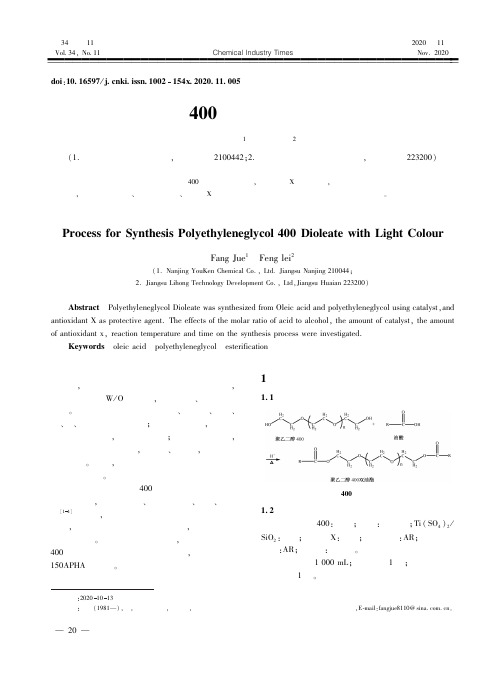
收稿日期:20201013作者简介:方珏(1981 ),男,硕士研究生,工程师,主要从事表面活性剂以及路面功能材料的研发和应用研究,E-mail:fangjue8110@㊂doi :10.16597/j.cnki.issn.1002154x.2020.11.005低色度聚乙二醇400双油酸酯的合成工艺的研发方㊀珏1㊀冯㊀磊2(1.南京友肯化工有限公司,江苏南京2100442;2.江苏利宏科技发展有限公司,江苏淮安223200)摘㊀要㊀简要介绍了油酸和聚乙二醇400在催化剂条件下,以抗氧剂X 为保护剂,进行聚乙二醇双油酸酯的合成过程,考察了酸醇比例㊁催化剂的用量㊁抗氧剂X 的用量以及反应温度和时间等因素对合成过程的影响㊂关键词㊀油酸㊀聚乙二醇㊀酯化反应Process for Synthesis Polyethyleneglycol 400Dioleate with Light ColourFang Jue 1㊀Feng lei 2(1.Nanjing YouKen Chemical Co.,Ltd.Jiangsu Nanjing 210044;2.Jiangsu Lihong Technology Development Co.,Ltd,Jiangsu Huaian 223200)Abstract ㊀Polyethyleneglycol Dioleate was synthesized from Oleic acid and polyethyleneglycol using catalyst,andantioxidant X as protective agent.The effects of the molar ratio of acid to alcohol,the amount of catalyst,the amount of antioxidant x,reaction temperature and time on the synthesis process were investigated.Keywords ㊀oleic acid㊀polyethyleneglycol㊀esterification ㊀㊀聚乙二醇双油酸酯属于一类重要的非离子表面活性剂,由于分子结构中存在酯基和聚氧乙烯基,因此可被广泛用W /O 型乳化,工业清洗㊁工业润滑等领域㊂在乳化行业可用于矿物油㊁植物油㊁煤油㊁农药㊁油㊁油基切削液乳化等;在工业清洗中,可用于配置工业去油垢剂,工业乳化清洗;在工业润滑体系,可作为金属切削用润滑剂,在纺织㊁制革上,是润滑剂的组成之一㊂因此,聚乙二醇双油酸酯在工业领域中具有重要的用途㊂国内目前聚乙二醇400双油酸酯主要采用直接酯化法制备,采用如硫酸㊁对甲苯磺酸㊁硼酸㊁固体酸等[14]催化剂,在酸性催化剂且高温条件下进行直接酯化,在此过程中产品色泽往往较深,一般都为琥珀色或深黄色㊂为了解决上述问题,本文对聚乙二醇400双油酸酯的合成进行了深入研究,可得到色度为150APHA 的产品㊂1㊀实验部分1.1㊀制备原理聚乙二醇400双油酯合成路线1.2㊀主要仪器和试剂聚乙二醇400:自制;油酸:工业级;Ti (SO 4)2/SiO 2:自制;抗氧剂X:自制;氢氧化钠:AR;聚醚用精制剂:AR;硅藻土:工业级㊂四口烧瓶1000mL;搅拌装置1套;循环水式多用真空泵1套㊂02㊀方㊀珏等.低色度聚乙二醇400双油酸酯的合成工艺的研发㊀2020.Vol.34,No.111.3㊀合成方法在1000mL四口烧瓶上安装温度计㊁氮气导管㊁电动搅拌器㊂依次加入油酸㊁聚乙二醇400㊁催化剂㊁抗氧剂X㊂温度升至210~220ħ,保温㊂用氮气流导出反应过程中生成的水,用酯化率判断反应进度和酯化反应终点㊂当反应至终点后,将物料降温,冷却到室温,经5%氢氧化钠溶液中和至酸值低于0.5mgKOH/g,加入精制剂和硅藻土与物料混合,通过吸附㊁过滤等步骤,得到最终产品,产品酯化率可达到97%,产品色度可达到150APHA㊂1.4㊀分析方法酸值:GB/T6365 2006‘表面活性剂游离碱度或游离酸度的测定“㊂色度检测:GB/T3143 2001‘液体化学产品颜色测定法(Hazen单位-铂-钴色号)“㊂酯化率计算公式:酯化率(%)=[1-(实测酸值-过量油酸折算的酸值)/理论酸值]ˑ100%理论酸值:针对聚乙二醇投料量所需理论的油酸折算的酸值㊂2㊀结果与讨论2.1㊀酸醇摩尔比对酯化率和色度的影响在一般聚乙二醇400和油酸反应过程中,往往加入过量油酸使反应完全,然后真空脱除油酸㊂通过调整酸醇摩尔比,对比投料量对产品酯化率的影响,按照如下投料,聚乙二醇400为200g(0.5mol),催化剂Ti(SO4)2/SiO2为2.41g(投料量的0.5%),抗氧剂X为2.41g(投料量的0.5%),在210~220ħ下反应,反应时间控制为8h,改变油酸的投料量,实验结果如下表1㊂表1㊀酸醇摩尔比对酯化率和色度的影响Tab.1㊀Effect of molar ratio of acid to alcohol onesterification rate and color酸醇摩尔比酯化率/(%)色度APHA2.00ʒ197.21502.05ʒ197.52002.10ʒ197.93002.20ʒ198.0深黄色㊀㊀从表1中可以得出,在相同反应时间内,酯化率随着酸醇摩尔比的增加而增加,在酸醇投料摩尔比达到2ʒ1后,提高酸醇摩尔比,其酯化率增加幅度趋缓,但是产品色度却随着酸醇摩尔比的增加而加深,这主要是因为过量的油酸需要在后期真空条件下脱除,导致产品色泽加深,因此综合考虑酯化率和色泽,选择酸醇摩尔比为反应理论配比2ʒ1㊂2.2㊀催化剂用量对酯化率和色度的影响为考查催化剂的用量对产品酯化率和色度的影响,按照如下投料,聚乙二醇400为200g(0.5mol),油酸为282g(1.0mol),抗氧剂X为2.41g(投料量的0.5%),在210~220ħ下反应,反应时间控制为8h,改变催化剂Ti(SO4)2/SiO2的用量,所得实验结果见表2㊂表2㊀催化剂用量对酯化率和色度的影响Tab.2㊀Effect of catalyst dosage on the esterificationrate and color催化剂用量W催化剂/W总投料量酯化率/(%)色度APHA0.25%94.21500.50%97.21500.75%97.52001.00%97.83001.25%97.8深黄色㊀㊀由表2可见,酯化率随催化剂用量的增加而增加,催化剂用量大于0.5%后,酯化率增加不明显,但是色度明显加深,这可能是因为随着催化剂使用量的增加,导致氧化副反应发生增多,从而使色泽加深,因此综合考虑催化剂用量选择0.5%㊂2.3㊀抗氧剂X添加量对产品色度的影响按照如下投料,聚乙二醇400为200g(0.5mol),油酸为282g(1.0mol)催化剂Ti(SO4)2/SiO2为2.41g(投料量的0.5%),在210~220ħ下反应,反应时间控制8h,改变抗氧剂X的用量,所得实验结果见表3㊂表3㊀抗氧剂X添加量对产品性能的影响Tab.3㊀Effect of Antioxidants X dosage on product performance 抗氧剂X W添加量/W投料量色泽0.2%3000.5%1500.8%1501.2%150㊀㊀从表3中可以得到,实验过程中随着抗氧剂X 添加量的增加,产品的色度明显改善,当抗氧剂X加入量为0.5%时,产品色度为150APHA㊂抗氧剂X 继续增加色度无变化,因此考虑在色泽较好的基础上,选择抗氧剂添加量为0.50%㊂12㊀2020.Vol.34,No.11㊀工艺试验‘Technology&Experiment“2.4㊀反应时间对酯化率的影响为考查反应时间对产品酯化率的影响,按照如下投料,聚乙二醇400为200g(0.5mol),油酸为282g(1.0mol),抗氧剂X为2.41g(投料量的0.5%),催化剂Ti(SO4)2/SiO2为2.41g(投料量的0.5%),在210~220ħ下反应,改变反应时间,实验结果见图1㊂图1㊀反应时间对酯化率的影响Fig.1㊀Effect of reaction time on the esterification rate 由图1可以得出,随着酯化反应的进行,酯化率增加明显,当反应时间超过8h,酯化率达到97%㊂继续增加反应时间酯化率无明显变化,但是随着反应时间增加,产品色度加深,并且造成不必要的能量浪费,所以综合考虑选择酯化时间为8h㊂2.5㊀反应温度对酯化率和色度的影响固定其它条件不变,只改变反应温度,考查其对产品酯化率和色度的影响,实验结果见表4㊂由表4得出,反应温度越高,酯化率增加明显,但是当反应温度大于215ħ后,在相同反应时间内的反应趋于平衡,酯化率几乎无明显变化,但是产品的色度却随着温度的增加而加深,这主要原因为反应较高,增加了氧化副反应的发生从而导致产品色度加深,所以综合考虑选择,反应温度控制在215ħ左右㊂表4㊀反应温度对酯化率和色度的影响Tab.4㊀Effect of reaction temperature on onesterification rate and color反应温度/ħ反应8h的酯化率/(%)反应8h色度APHA19586.510020592.115021597.215022597.530023597.93003㊀结论通过条件影响因素试验,得出聚乙二醇400双油酸酯的合成工艺如下:酸醇摩尔比为2.0ʒ1,催化剂Ti(SO4)2/SiO2添加量为0.5%,抗氧剂X添加量为0.5%,反应温度控制在215ħ左右,反应时间为8h,酯化率可达到97%,然后粗品经5%氢氧化钠溶液中和,加入精制剂和硅藻土,经吸附㊁过滤等步骤,得到最终产品,产品色度可达到150APHA㊂参考文献[1]安红,田志茗,宋伟明.混酸PEG酯的合成及性能研究[J].精细石油化工,1998(5):2123.[2]章城亮,王义永,盛晓园,丁婷婷,李祥清.聚乙二醇400单油酸酯的研发及生产[J].浙江化工,2014.45(7): 3032.[3]李行,陈永杰,巴红亮等.硼酸酯法合成聚乙二醇(400)单蓖麻油酸酯[J].精细石油化工,2013.30(4):2933.[4]冯光瑛,杨仁春,魏天俊等.固体超强酸SO2-4/ZrO2催化合成硬脂酸聚乙二醇400单酯的研究[J].日用化学工业,1998(5):1214.ʏʏʏʏʏʏʏʏʏʏʏʏʏʏʏʏʏʏʏʏʏʏʏʏʏʏʏʏʏʏʏʏʏʏʏʏʏʏʏʏʏʏʏʏʏʏʏʏ第三代甲醇制烯烃技术通过鉴定中国科学报11月16日讯,第三代甲醇制烯烃(DMTOⅢ)技术11月9日在北京通过了中国石油和化学工业联合会组织的科技成果鉴定㊂该技术由中国科学院大连化学物理研究所研发,具有完全自主知识产权㊂鉴定专家一致认为,该成果创新性强,具有完全自主知识产权,成果处于国际领先水平,技术优势明显,引领行业技术进步,应用前景广阔;建议加快新一代催化剂推广应用,并早日建成DMTOⅢ工业示范装置㊂巴斯夫扩大在中国的涂料助剂生产规模化工网11月24日讯,巴斯夫位于中国南京的全资生产基地近日扩大生产规模,增加了其先进助剂产能㊂巴斯夫南京基地主要为各大终端行业(包括涂料㊁胶粘剂㊁印刷和复合材料)的客户提供服务㊂此次装置扩建不仅能帮助客户及供应商缩短交货时间,简化物流流程,还能减少碳排放㊂巴斯夫南京基地自2013年起投入运营,该基地已经实现废水零排放,废气排放也符合国内日益严格的环保要求㊂22。
聚乙二醇和硼酸的反应
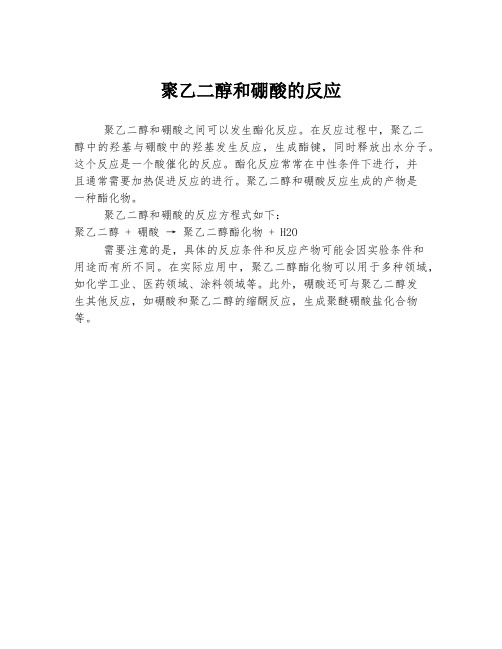
聚乙二醇和硼酸的反应
聚乙二醇和硼酸之间可以发生酯化反应。
在反应过程中,聚乙二
醇中的羟基与硼酸中的羟基发生反应,生成酯键,同时释放出水分子。
这个反应是一个酸催化的反应。
酯化反应常常在中性条件下进行,并
且通常需要加热促进反应的进行。
聚乙二醇和硼酸反应生成的产物是
一种酯化物。
聚乙二醇和硼酸的反应方程式如下:
聚乙二醇 + 硼酸→ 聚乙二醇酯化物 + H2O
需要注意的是,具体的反应条件和反应产物可能会因实验条件和
用途而有所不同。
在实际应用中,聚乙二醇酯化物可以用于多种领域,如化学工业、医药领域、涂料领域等。
此外,硼酸还可与聚乙二醇发
生其他反应,如硼酸和聚乙二醇的缩酮反应,生成聚醚硼酸盐化合物等。
二乙醇胺硼酸酯的合成
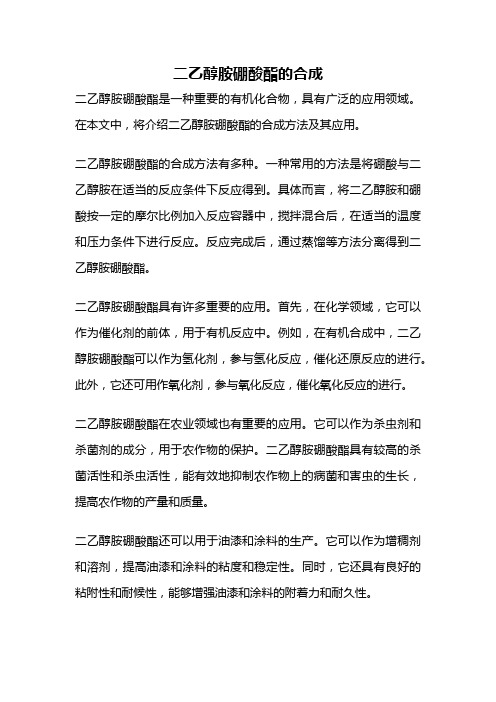
二乙醇胺硼酸酯的合成二乙醇胺硼酸酯是一种重要的有机化合物,具有广泛的应用领域。
在本文中,将介绍二乙醇胺硼酸酯的合成方法及其应用。
二乙醇胺硼酸酯的合成方法有多种。
一种常用的方法是将硼酸与二乙醇胺在适当的反应条件下反应得到。
具体而言,将二乙醇胺和硼酸按一定的摩尔比例加入反应容器中,搅拌混合后,在适当的温度和压力条件下进行反应。
反应完成后,通过蒸馏等方法分离得到二乙醇胺硼酸酯。
二乙醇胺硼酸酯具有许多重要的应用。
首先,在化学领域,它可以作为催化剂的前体,用于有机反应中。
例如,在有机合成中,二乙醇胺硼酸酯可以作为氢化剂,参与氢化反应,催化还原反应的进行。
此外,它还可用作氧化剂,参与氧化反应,催化氧化反应的进行。
二乙醇胺硼酸酯在农业领域也有重要的应用。
它可以作为杀虫剂和杀菌剂的成分,用于农作物的保护。
二乙醇胺硼酸酯具有较高的杀菌活性和杀虫活性,能有效地抑制农作物上的病菌和害虫的生长,提高农作物的产量和质量。
二乙醇胺硼酸酯还可以用于油漆和涂料的生产。
它可以作为增稠剂和溶剂,提高油漆和涂料的粘度和稳定性。
同时,它还具有良好的粘附性和耐候性,能够增强油漆和涂料的附着力和耐久性。
除了以上应用外,二乙醇胺硼酸酯还可以用于制备聚合物材料。
它可以作为聚合反应的催化剂,参与聚合反应的进行。
通过调节反应条件和配比,可以得到具有不同性质和用途的聚合物材料,如聚酰胺、聚酯等。
二乙醇胺硼酸酯是一种重要的有机化合物,具有广泛的应用领域。
通过合适的合成方法可以得到二乙醇胺硼酸酯,并应用于化学、农业、油漆涂料以及聚合物等领域。
随着科学技术的不断发展,对二乙醇胺硼酸酯的研究和应用将进一步深入,为人类的生产和生活带来更多的便利和效益。
- 1、下载文档前请自行甄别文档内容的完整性,平台不提供额外的编辑、内容补充、找答案等附加服务。
- 2、"仅部分预览"的文档,不可在线预览部分如存在完整性等问题,可反馈申请退款(可完整预览的文档不适用该条件!)。
- 3、如文档侵犯您的权益,请联系客服反馈,我们会尽快为您处理(人工客服工作时间:9:00-18:30)。
学 生 毕 业 论 文课题名称聚乙二醇硼酸酯的合成姓 名李腊 学 号1008102-20 院 系化学与环境工程学院 专 业化学工程与工艺 指导教师周攀登讲师2014年6月02日※※※※※※※※※※※ ※※※※ ※※※※※※※※※ 2014届学生毕业设计(论文)材料 (四)湖南城市学院本科毕业设计(论文)诚信声明本人郑重声明:所呈交的本科毕业设计(论文),是本人在指导老师的指导下,独立进行研究工作所取得的成果,成果不存在知识产权争议,除文中已经注明引用的内容外,本设计(论文)不含任何其他个人或集体已经发表或撰写过的作品成果。
对本文的研究做出重要贡献的个人和集体均已在文中以明确方式标明。
本人完全意识到本声明的法律结果由本人承担。
本科毕业设计(论文)作者签名:二○一四年六月二日目录1. 绪论 (4)1.1 有机硼酸酯的介绍 (4)1.2 有机硼酸酯的合成方法 (5)1.3铝电解电容器 (6)1.3.1节能灯专用中高压铝电解电容器[4] (6)1.3.2高压铝电解电容器的工作电解液 (7)1.3.3高压铝电解电容器工作电解液的研究进展 (8)1.3.4工作电解液耐高压添加剂的研究进展 (8)1.4有机含硼化合物在导电介质中的应用研究进展 (9)1.5 研究目的、主要工作及意义 (11)1.5.1 研究目的 (11)1.5.2 主要工作 (11)1.5.3 研究意义 (11)2. 聚乙二醇硼酸酯的合成 (13)2.1 引言 (13)2.2 实验部分 (13)2.2.1 实验原料与器材 (13)2.2.2合成原料的选择与合成条件筛选 (14)2.2.3 聚合反应装置 (15)2.2.4 操作方法 (15)3. 结果与讨论 (16)3.1 聚乙二醇硼酸酯的合成工艺 (16)3.1.1 正交实验结果 (16)3.2 产物红外光谱分析 (21)4 结论 (21)参考文献 (21)聚乙二醇硼酸酯的合成李腊(湖南城市学院化学工程与工艺专业2014届学生)摘要:本文采用正交实验和单因素实验方法探讨了硼酸聚酯的最优合成工艺;以最优的工艺条件合成了聚乙二醇硼酸酯。
用红外光谱测试并分析了聚乙二醇硼酸酯的结构。
聚乙二醇硼酸酯的最佳反应条件为:反应温度150℃,共沸剂(苯)的用量等于物料产物水的体积的1.5倍,反应时间50min,反应物摩尔比(PEG:硼酸)3.1:1,硼酸酯化率可达到73.8%关键词:铝电解电容器;硼酸聚酯;工作电解液。
The synthesis of polyethylene glycol (peg) boric acid esterLi La(2014 Year Student of Chemical Engineering and Technology Major, Hunan City University)Abstract:In this paper, orthogonal and single factor experimental studies was employed in the optimal synthesis of boric acid polyester; The optimal process conditions of synthesis of boronic ester. Analysis of the structure of polyethylene glycol borate and infrared spectroscopy. The optimum reaction conditions of polyethylene glycol borate were: reaction temperature is 150 ℃, azeotropic agent (benzene) 1.5 times the amount equal to the material product water volume, reaction time is 50min, the molar ratio of reactants (PEG: boric acid) is 3.1:1, Boric acid esterification rate can reach 73.8%.Key words: aluminum electrolytic capacitor; boronic polyester; working electrolyte.1. 绪论1.1 有机硼酸酯的介绍自从1846年Ebelman和Bouquet[1]合成了硼酸三甲酯、乙酯、戊酯等有机硼酸酯以来,有机硼化合物的研究己有一百多年的历史了。
随着近代工业发展的需要,以及尖端科学技术的特殊要求,有机硼化合物化学得到了迅速的发展,各种结构的硼酸酯不断地被合成出来,并被广范地应用到工业生产的各个领域。
有机硼高分子化合物是高分子化学中的一个新的领域,由于硼化合物的特殊性能,近年来,随着工业技术的飞速发展,有机含硼高分子化合物的合成与应用方面的研究领域不断地被拓宽,有机硼高分子在导电介质中的应用价值也逐渐为人们所发现,在电化学电容器中的应用得到了令人满意的结果。
有机硼酸酯化合物是一类以硼酸为母体,形成B-O键的硼酸酯类的化合物,即B(OR),其中,R一可以为烷基,醚醇残基等。
31.2 有机硼酸酯的合成方法硼是一种无毒、无公害的非金属元素,具有优的耐热、阻燃、耐磨以及质轻等无与伦比的特性。
硼原子[2]的电子层结构是1S2 2S2 2P1,其中2S电子容易被激发到2P轨道上成激发态,形成三个未成对电子,即在价电子层中能提供成键的电子是2S12Ps12Py1,因此硼原子往往以SP2杂化轨道的形式形成平面六隅体电子结构的三价化合物。
由于硼原子形成平面六隅体电子结构的三价化合物后还有一个P 轨道是空的,所以它具有显著的缺电子性,可以与电子给予体(如O , N等)的孤电子对形成典型的共价配位键,硼原子的杂化轨道改变,由SP2到SP3,形成八隅体的稳定电子结构。
硼在形成化合物时的成键特征可归纳为三点:共价性、缺电子性和多面体性。
基于硼的这种亲电子性,它能形成许多含有B-O键的化合物,包括B-O键同有机基团连接的范围极广的有机硼化合物,这也是硼在形成化合物时的重要成键特性之一。
结构简单的正硼酸酯化合物可以通过下列途径合成得到:(1)三卤化硼与醇(或酚)反应此法按化学方程式中的硼酸与三氯化硼化学计量比投料反应,硼酸酯的产率几乎是定量的,但由于三氯化硼比较难得,因此,此法未得以推广利用。
(2)硼酸与醇(或酚)反应反应过程中加入少量的无机酸(如HCl或HZSO训守有利于硼酸酯的生成,同时,在反应体系中引入一些非极性溶剂(苯、甲苯、四氯化碳等),可形成如苯一醇一水共沸物,有利于水的去除。
(3)硼酸与醇(或酚)反应(4)酯交换反应反应需在高压釜中进行,采用旋转式高压反应釜更通常用低级醇的正硼酸酯为原料,在高级醇的存在下,加热回流,可得到高级醇的正硼酸酯,如用硼酸三甲酯为原料合成高级醇的硼酸酯。
1.3铝电解电容器铝电解电容器以单位体积电容量大、体积小、重量轻、价廉而著称,广泛应用在电子镇流器、通讯用具、IT行业电子产品、工业变频器、工业开关电源、电动汽车等电子设备中。
在各种电子电路中具有低频滤波、高频偶合、隔直流、储能等功能,是大量使用的、不可取代的电子元件之一。
1.3.1节能灯专用中高压铝电解电容器[4]随着经济快速发展,目前世界各国能源紧缺问题口益突出,节约能源、保护生态环境己是全球发展趋势。
电子节能灯因具有独特的节能省电、高显色、高光效以及长寿命等优点极受人们青睐,被广泛应用于工厂、商场、酒店以及家庭等照明,市场前景非常广阔。
电子节能灯因其特殊使用环境,首先产品外型一般设计为紧凑型,且长时间连续工作,灯管产生的热量导致线路板温升较高;其次是灯开关频率高,产生较高瞬间电压、电流冲击;再次是电子线路中存在较高纹波电流,电容器自身发热量较高以及工作电压高。
对于电子节能灯用关键元器件铝电解电容器,上述使用环境对其破坏非常严重,电容器自身质量高低直接影响电子节能灯的使用寿命。
国内电容器厂商近几年在中、高压铝电解电容器技术开发上虽取得了一定进步,但与国外同行厂商还是存在较大差距。
国内产品在照明行业的应用目前主要是集中在中、低端电子节能灯市场,而高端电子节能灯用电容器主要是从口本RUBYCON, CHEMI-CON以及NICHICON等厂家进口。
为振兴我国民族经济,缩短与国外产品在技术水平上的差距,国内铝电解电容器生产商需联合上游铝箔、化工等原材料生产企业共同努力,解决产品在照明领域使用时存在的不足。
对于大功率电子节能灯,在长时间正常使用时,灯管会产生大量的热量,导致灯具内部线路板温度高达90 ℃以上,而目前电子节能灯厂家在对铝电解电容器做寿命检测认证时,往往是采用提高温度做整灯加速试验,此时电容器承受的环境温度高达125 ℃。
因此,传统的工作温度上限为105 ℃高温电容器产品己不能满足大功率电子节能灯要求,为顺应电子节能灯技术的发展,急需开发工作温度上限能达到125 ℃高温以上的中、高压铝电解电容器。
1.3.2高压铝电解电容器的工作电解液工作电解液[5]是铝电解电容器的实际阴极,起提供氧离子、修补铝阳极氧化膜的重要作用,对产品的使用温度范围、工作寿命、可靠性、漏电流、损耗、容量变化等电性能起决定作用。
中高压铝电解电容器[6]工作电解液一般要求具有高的氧化效率、较稳定的物化性质、较小的电阻率、高的闪火电压等,且pH值接近中性,对铝箔和密封材料无腐蚀,即应具有以下特点:(1)较高的电导率:为了制得低阻抗、耐高频高纹波的中高压铝电解电容器,工作电解液必须具备较高的电导率。
(2)高闪火电压:为保证中高压铝电解电容器的工作电压UW,工作电解液的闪火电压U,需要有一定的富余值,即US=1.2UW 。
因此高压工作电解液要求US>_480V,中压工作电解液要求US>_400 V 。
(3)高氧化效率:中高压电容器产品要求工作电解液有较高的氧化效率,以尽快修复被损坏的介质氧化膜层。
如果,工作电解液的氧化效率不高,则产品的高温负荷寿命会减短,对高压产品,在老练过程中可能出现电压上升缓慢,产品发热,电压回落,电流回升,产品突然击穿爆管等问题。
(4)低饱和蒸汽压:中高压铝电解电容器的工作电解液饱和蒸汽压必须很低,才能抑制电解液在高温下蒸发与散逸,延长电容器使用寿命。
(5)物化性能稳定,使用寿命长:工作电解液应保证中高压铝电解电容器能在105℃高温下正常工作时间大于10000 h。
电容器的寿命计算遵循10 ℃法则,主要考察中高压铝电解电容器在125 ℃负荷3 000 h的寿命状况。
